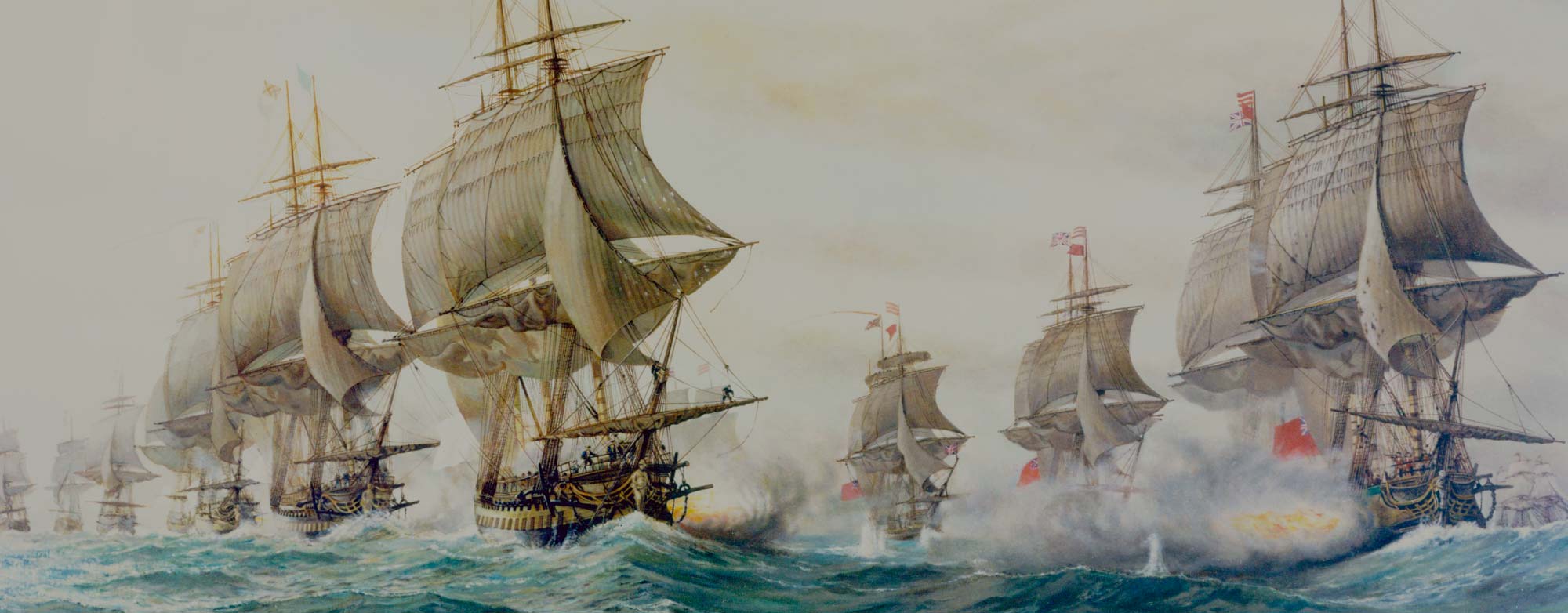
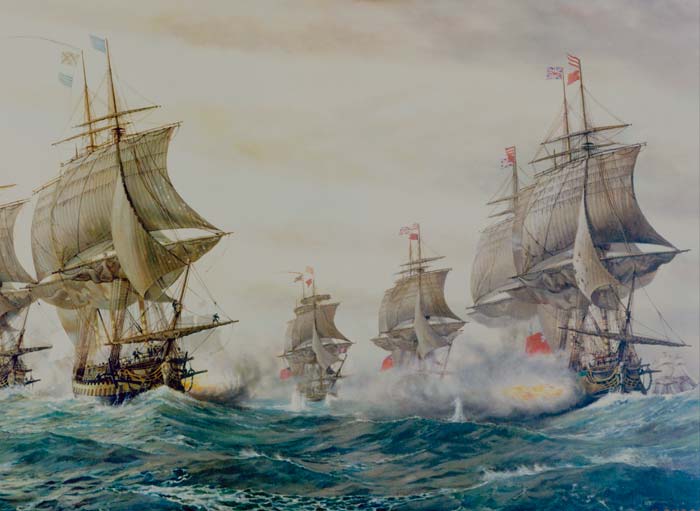


The lure of the sea has captured the imaginations of many. The rich, the poor, the famous and infamous. The tales of old told of giant sea creatures lurking in the murky depths, stalking ships across the oceans of the world. Legends of famous pirates looting and raiding any ship that was slow enough to be boarded. New world explorers shipwrecked on strange, foreign shores or vessels loaded with gold and precious jewels lost to the deep, dark seas. The sea has been a source of inspiration for artists, writers, musicians, poets, explorers. 20,000 Leagues Under the Sea by Jules Verne or Moby Dick by Herman Melville, the wild and untameable beauty of mother nature is a constant source in the story of human endeavour. And throughout many of the adventures, fact and fiction, alcohol appears to have been a constant companion. Brandy, wine, beer, port, rum and of course gin.
To become a sailor, a young boy would start his apprenticeship before reaching fourteen years of age, with the ship’s master or first mate paid a sum by the parents. This unpaid apprenticeship could last up to nine years, but once the training was complete, it would mean the young sailor could quickly move to be a ship’s master or first mate by the time they reached their mid-twenties. For poorer families, a ship’s master could be given a boy without payment in understanding that the boy would be given a bed and a meal aboard a ship. The boy would also be provided with some form of training so they could have some life and career at sea. It was this or endure a life of desperation and poverty on dry land that would lead to an early grave. Although life expectancy for a young boy aboard a ship of burly men, facing deadly storms and all the wrath that mother nature could throw at you didn’t exactly bode well either for a long and happy life.
For many sailors in the 17th century, life at sea meant months and sometimes years away from family. Cramped and dirty living quarters could quickly develop into a place of absolute squalor, which could often lead to illness. Sometimes when a ship’s crew became sick quickly, rumours would spread of a cursed voyage or that a member of the crew might carry the black mark, a sign of danger and foreboding amongst seafarers. Often tired, malnourished, superstitious, and a long way from home, it’s easy to see why any distraction from the reality of life at sea would be a welcome escape. Spending months at sea with the same faces working tirelessly under the strict stewardship of a ship’s captain could have been enough to push anyone to the grog as a welcome escape.
A little sip of something here and there helped lighten the mood but also a literal and proverbial powder keg waiting for a spark. An ill-prepared ship’s hold could be the downfall of many an experienced captain and crew. A lack of fresh drinking water, fruit, meat and vegetables could push the crew of a ship to breaking point resulting in mutiny. Or worse, murder. With their physical and mental health pushed to the limits, it’s easy to understand why a crew’s morale could make or break a voyage.
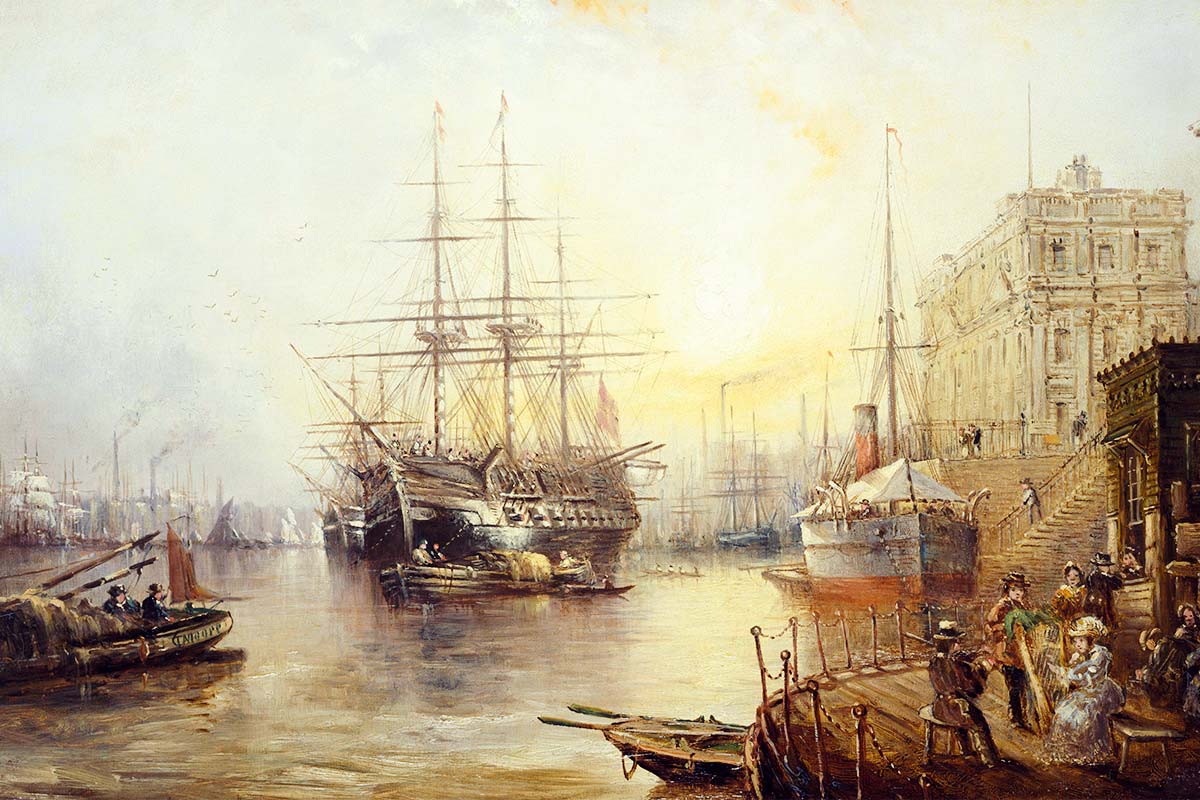
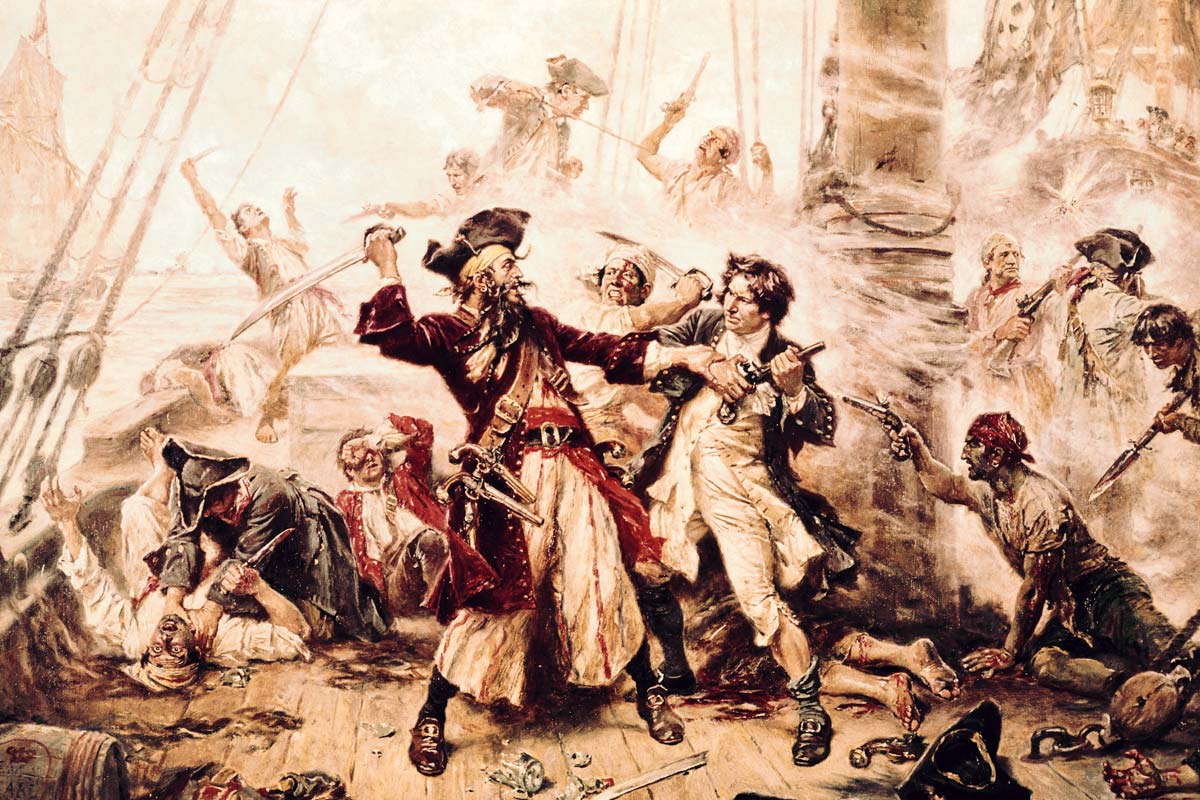
During the 17th and 18th centuries, most sea voyages required a significant cargo of fresh water to keep the crew healthy. Unfortunately, the water which was stored in casks could quickly develop algae rendering the water almost undrinkable. And although stopping at ports to resupply provided a chance to top up water, there was no guarantee that the water being brought on board was fresh or safe to drink. Sometimes the water on board would become so vile that under captains orders, a cask of stale water would be topped up with beer, wine, rum or any other spirits on board to dilute the pungent odour and taste. A lack of water could literally mean life or death for the crew. With freshwater posing an on-going problem for voyages and expeditions to far-flung lands, there could be only one solution? Bring less water and more booze instead.
‘There were nights when he took a deal more rum and water than his head could carry; and then he would sometimes sit and sing his wicked old wild sea-songs, minding nobody… Often I have heard the house shaking with Yo-ho-ho and a bottle and rum, all the neighbours joining in for dear life with the fear of death upon them and each singing louder than the other to avoid remark.’ “Fifteen men on the dead man’s chest, Yo-ho-ho and a bottle of rum! Drink and the devil have done for the rest. Yo-ho-ho and a bottle of rum!” Robert Louis Stevenson, Treasure Island (1883)
As the Royal Navy sailed the high seas flying the flag for the British Empire, an attack in 1655 saw the Island of Jamaica come under the empire’s control. Several other islands would eventually be absorbed as part of the British Empire and resulted in the popularity of a new kind of alcohol – rum. Rum would eventually become the spirit of choice for the Royal Navy.
By 1731, thanks to its longer shelf life than some of the other drinks that could be found aboard a ship, and the fact that rum was safer to drink than, for example, Arak, an Indian Spirit drink which sailors came to distrust thanks to its tendency to make the drinker sick, rum became the drink of the Royal Navy, although officers often drank sherry, port and gin. Rum rations were issued to sailors twice a day in half-pint jugs, also known as ‘tots’ right up until 1823 when it was cut to a quarter pint, and then 1850 an eighth of a pint where it stayed right up until 1970.
With an increasing demand for liquids that could last long voyages, spirits seemed like the perfect solution. Not only did most spirits remain palatable, but with the addition of spices and herbs that were aboard the ship, this would hide any spoiling of the alcohol, and a drink could also lift the spirits of even the weariest of sailors.
With many ports and harbours acting as gateways to the world, the life of a mariner meant they came into contact with goods from around the world at nearly every port: exotic spices, luxurious textiles, strange animals, new languages, cultures. And of course, new types of drink. It’s little wonder that many ports saw the growth of breweries and distilleries all within a stone’s throw of the harbour front. With a thirsty, ever-changing roster of customers, there was money to be made. It didn’t matter how the liquid tasted, as long as it brought merriment and joviality, an exchange of coin would be made by sea weary sailors setting foot on dry land for the first time in months, eager to get their fill at the nearest free house or in some cases, illicit distillery.
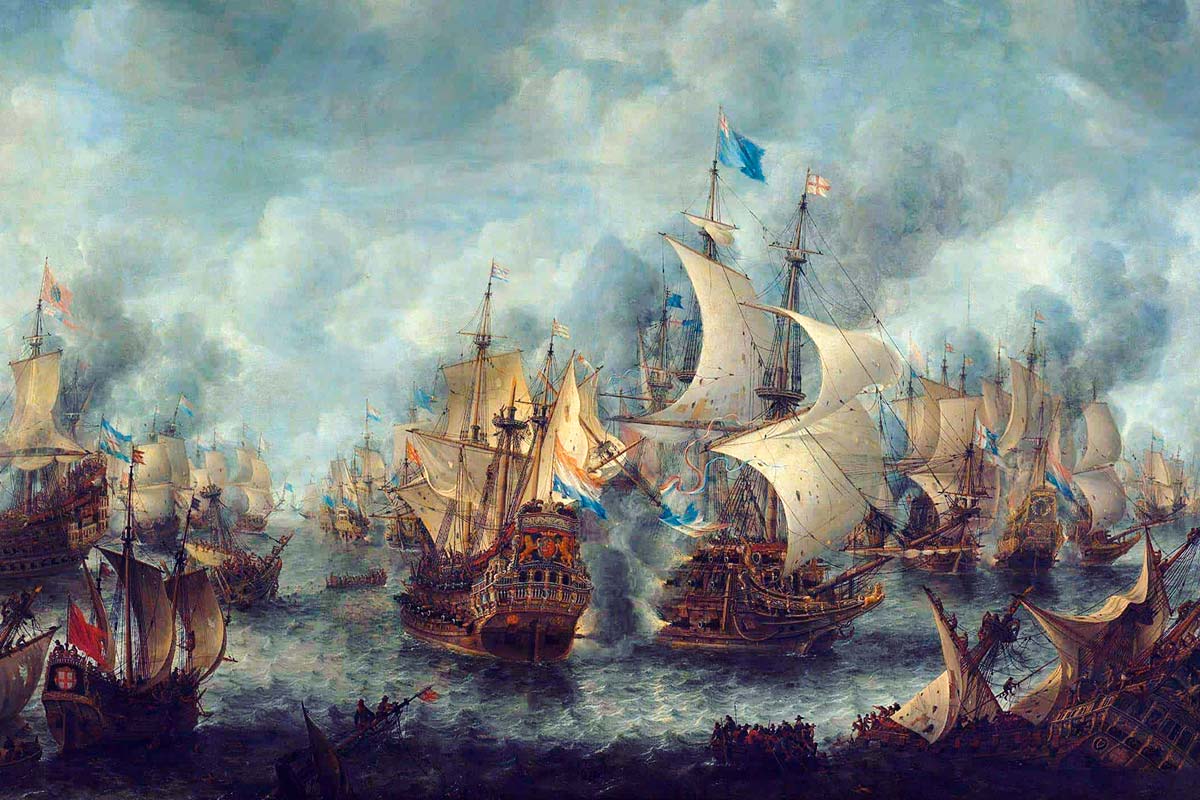
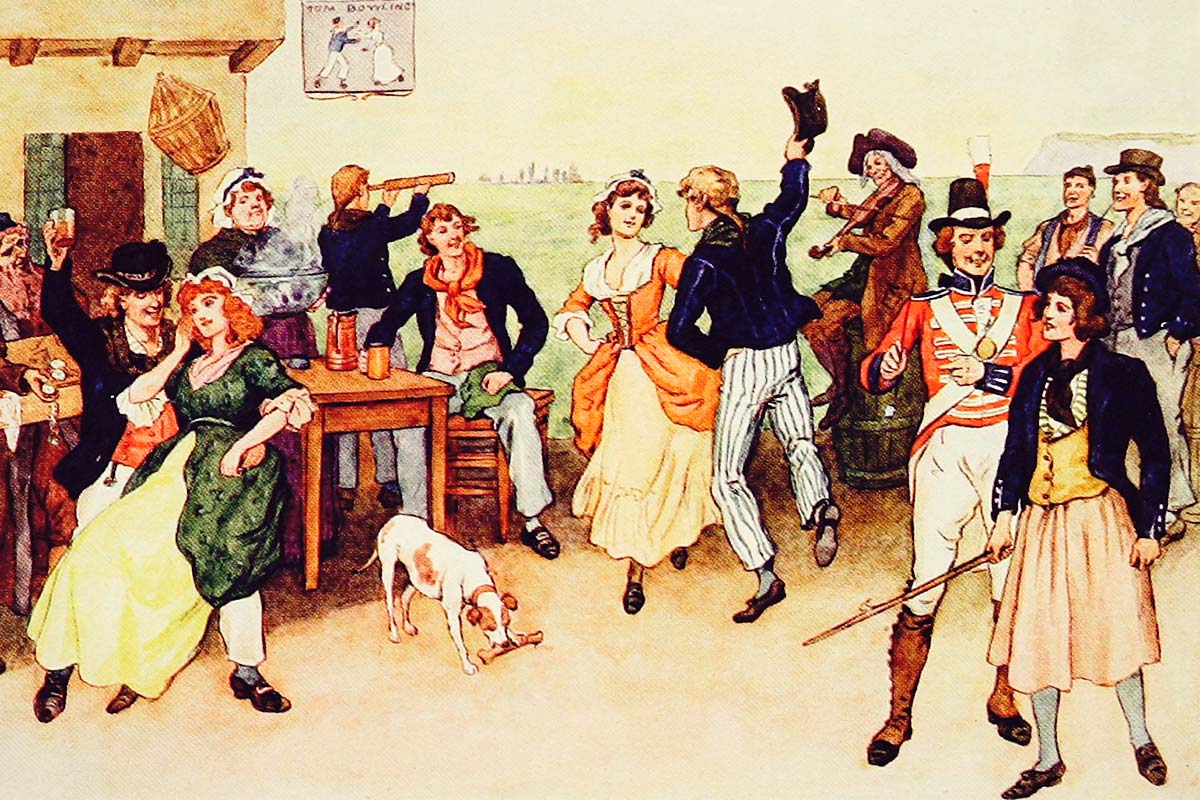
And although gin was traditionally reserved for the officers on the ship whilst the lower-ranking sailors and crew were allocated a ration of rum, thanks to the number of distilleries in any given port, it was easy for sailors to get their hands on a few bottles of gin or any other booze that their purse could afford. And sometimes, it was a case of purchasing whatever spirits were readily available at the next port of call.
One port that saw a boom in alcohol production was Plymouth. The Black Friars Distillery, now The Plymouth Gin Distillery, opened its doors in 1793 in the port of Plymouth. The distillery produced Plymouth Gin, a style of gin that was slightly sweeter and less dry than London Dry gin. Its flavour profile, along with the fact it could be drunk neat, quickly found favour amongst officers. It had a certain air of sophistication and quality, something many rums of the time lacked. Plymouth Gin proved so popular it became a tradition in the Royal Navy that all newly commissioned vessels receive a “Plymouth Gin Commissioning Kit”, a wooden box containing two bottles of navy strength Plymouth gin and glassware. Up until 2015, Plymouth Gin was a Protected Geographical Indication, which meant Plymouth Gin had to be made in Plymouth.
With demand for alcohol, beer, rum, brandy and eventually gin, thanks in part to the gin craze in the first half of the 18th century, it may come as no surprise to learn that many of the Royal Navy’s manifests from the 17th century onwards included rum, beer, brandy, port, wine and of course gin, although many manifests note ‘genever’ up until the name and spirit evolved to be known as gin.
Ordering large quantities of gin meant there was a chance the distillery or seller might try and hoodwink the Royal Navy. It was up to the ‘Pussers’, Royal Navy slang for a ship’s supply officer as they were in charge of the ships purse, to make sure that the Royal Navy was not left red-faced and out of pocket. The last thing the Pusser would want would be a stern dressing down, or worse, from a disgruntled captain who found out half way around the world that barrels of gin in his hold was tasteless, watered-down slop that had gone off. The Pussers had to find a way of ensuring that the gin they were purchasing was of high strength.
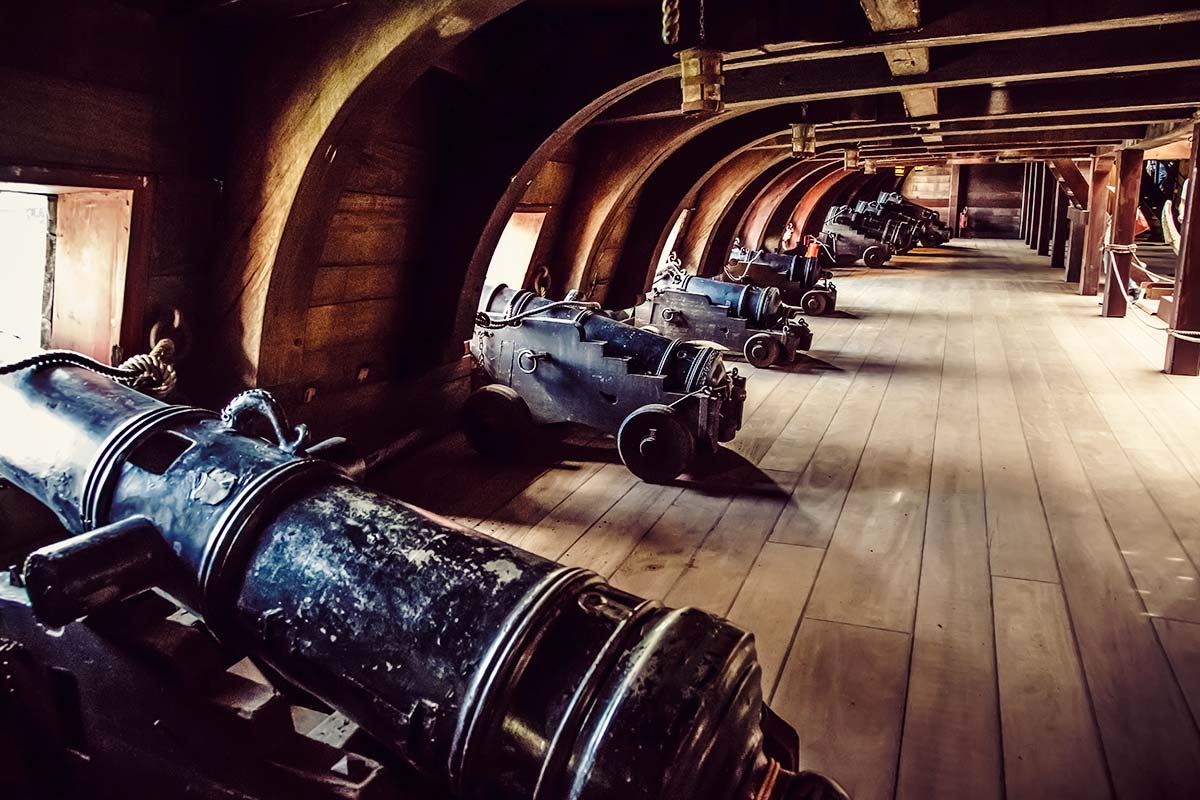
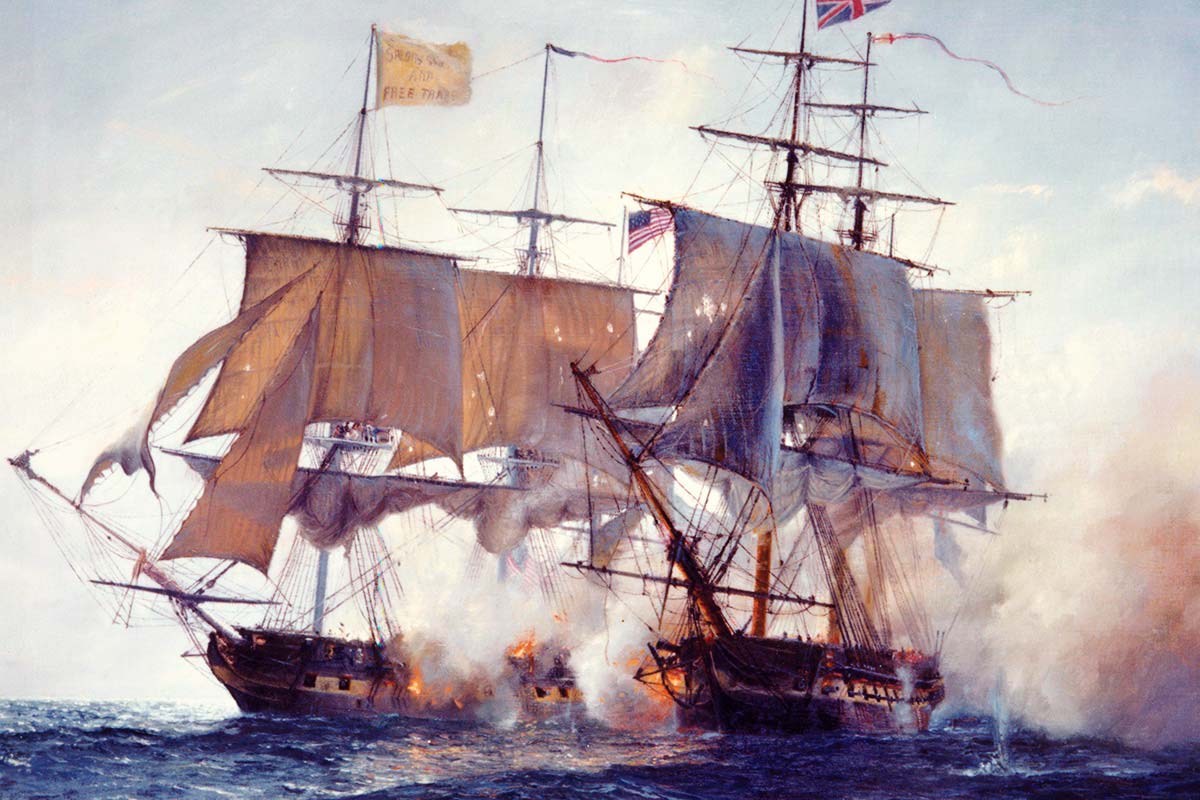
There are a number of stories relating to how the strength of gin was tested, but many, if not all, involved the use of gunpowder. Up until 1816, there was no method to test the ABV of a spirit, so a test was devised that would provide a good indication of the strength. A few grains of gun powder would be mixed with a small measure of gin from each cask. The solution would then be ignited to see if the gunpowder and liquid would burn. If the gin ignited and created a flame, then this was ‘proof’ that the gin was of a ‘high proof strength’. If the gunpowder failed to ignite, then this was a strong indicator that the gin wasn’t high strength and had most likely been watered down. Bearing in mind that the gin we know today at a minimum 37.5% ABV is a completely different spirit to the gin that would have been served in the officers quarters at high strength.
Testing gin and other spirits using the gunpowder test also meant that if a cask broke in the ship’s hold and the gunpowder stores were flooded, or the gunpowder was damp, in theory, it should still ignite. Faced with battles on the high sea and with the British Empire and Royal Navy’s reputation at stake, the last thing a Captain or crew would want was soggy gunpowder, which would have rendered their cannons useless. Having to explain at a court-martial, you lost one of the King’s royal fleet because you had a problem with ‘soggy gunpowder’ would have seen any officer’s reputation diminished beyond repair.
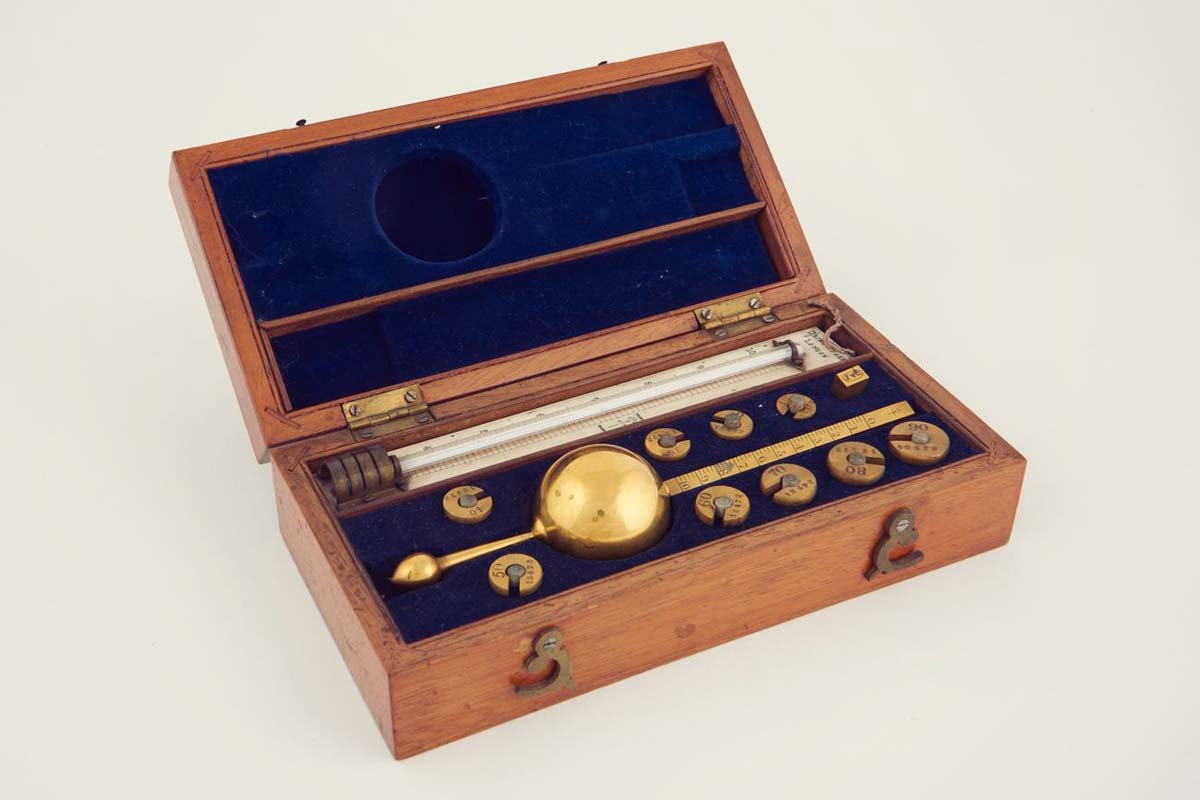
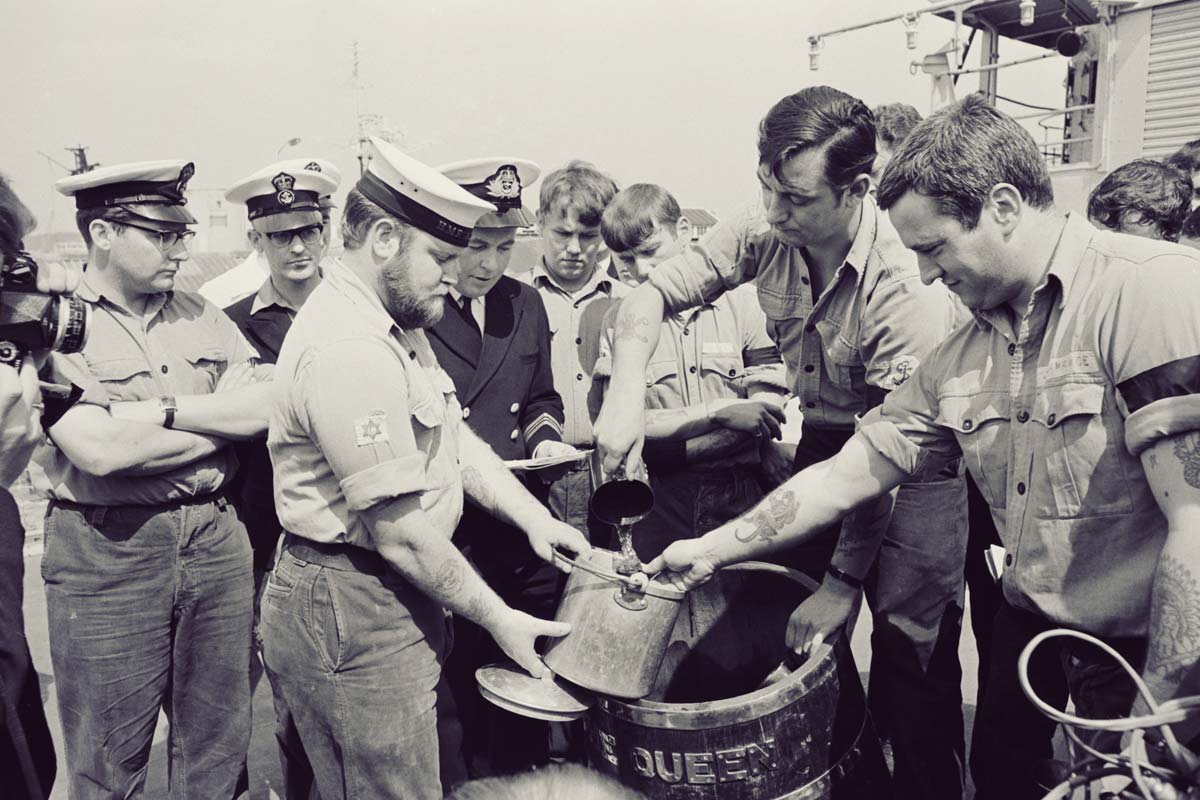
It was only in 1816 when Bartholomew Sikes invented the alcoholometer that the volume of alcohol in a liquid could be measured. The Royal Navy quickly adopted the alcoholometer; before it was introduced into law in 1818, it was discovered that the minimum ABV required by the Navy was 57.5% ABV. Although after some tests, the Royal Navy discovered the ideal strength for igniting gun powder was 54.5% ABV, and so for the next 150 years, this was the ABV of gin supplied to the Royal Navy. It wasn’t until the 31st of July 1970 that the Royal Navy ceased daily rations of alcohol to crew members, a day that’s known as “Black Tot Day”, which was brought about by The Admiralty Board writing to the House of Commons on the 17th of December 1969.
“The Admiralty Board concludes that the rum issue is no longer compatible with the high standards of efficiency required now that the individual’s tasks in ships are concerned with complex, and often delicate, machinery and systems on the correct functioning of which people’s lives may depend.” In other words, inebriated sailors shouldn’t be operating million-pound naval vessels.
It was only in 1993, 23 years after “Black Tot Day” that the term ‘Navy Strength’ was actually used to brand a gin. For the most part, they were referred to as overproof gin or 100% Proof gin. The term ‘Navy Strength’ is in fact thanks to John Murphy, a marketing consultant who was working with the team at The Plymouth Gin Company. John created the term ‘Navy Strength Gin’ to help market the distillery’s 100% Proof gin. And thus, the modern term for high strength gin was born.
Today, Navy Strength Gins come in all manner of strengths and styles, including cask-aged navy strength gins and old tom navy strength gins. The ideal ABV should be over 57% ABV and there are a number of high strength gins that use the idea of the Navy Strength category to market their high strength gins according to their own story or region, including Highland Strength and Battlefield Strength.
Below you’ll discover a variety of Navy Strength and high strength gins from our members to explore…
Little Brown Dog Latitude Strength (57.5% ABV), Little Brown Dog Distillery
Little Brown Dog Distillery, based in rural Aberdeenshire, was established by friends Andrew Smith and Chris Reid. The micro-distillery, which sits in the shadow of Bennachie, a local landmark, produces Scottish Gin along with bottling a variety of cask whiskies, blended whiskies, brandy and more. The distillery is a hub of creativity that seeks to break down barriers, and dispel some of the stereotypes that can be associated with gin and whisky.
Inspired by the local landscape and Andrew’s dog, the original ‘Little Brown Dog’, the distillery has released a number of creative spirits as part of their Experimental Spirit Series. Alongside these, Little Brown Dog released its signature LBD Gin in May 2020. The gin used a variety of locally Aberdeenshire foraged botanicals including parsnip, a first for Scottish Gin, and birch sap, beech leaves, bee pollen and a number of classic gin botanicals. Exploring new botanicals, foraging for flavour, distilling with purpose.
There’s also a hearty does of sarcasm, fun, Micky-taking and self-mockery that’s part of the distillery DNA. Andrew and Chris want to produce spirits that get people talking, that can encourage drinkers to step away from the expected and challenge and nudge boundaries when it comes to the norm. Their Unlimited Edition tagline on their LBD Gin gently mocks the drinks industry where big brands producing gin by the truckload can plaster ‘Limited Edition’ on a bottle to cash in. Or the use of the local Doric dialect ‘affa strong’ on their new Latitude Strength which translates to ‘it’s really strong, don’t be an idiot and go easy – this gin is strong’.
Being able to produce good gin and spirits is a challenge. But being able to inject some personality and fun into what you do without resorting to cheap gags or ill-advised memes can be even harder. Making gin fun isn’t hard. But getting it right is. Andrew and Chris manage to find that fine balance of producing, shaping and sourcing great tasting liquids that are unique and original, whilst putting their own LBD stamp on things, underlined with their motto “Forage what we can, grow what we can’t and only buy what we cannot grow or forage sustainably”.
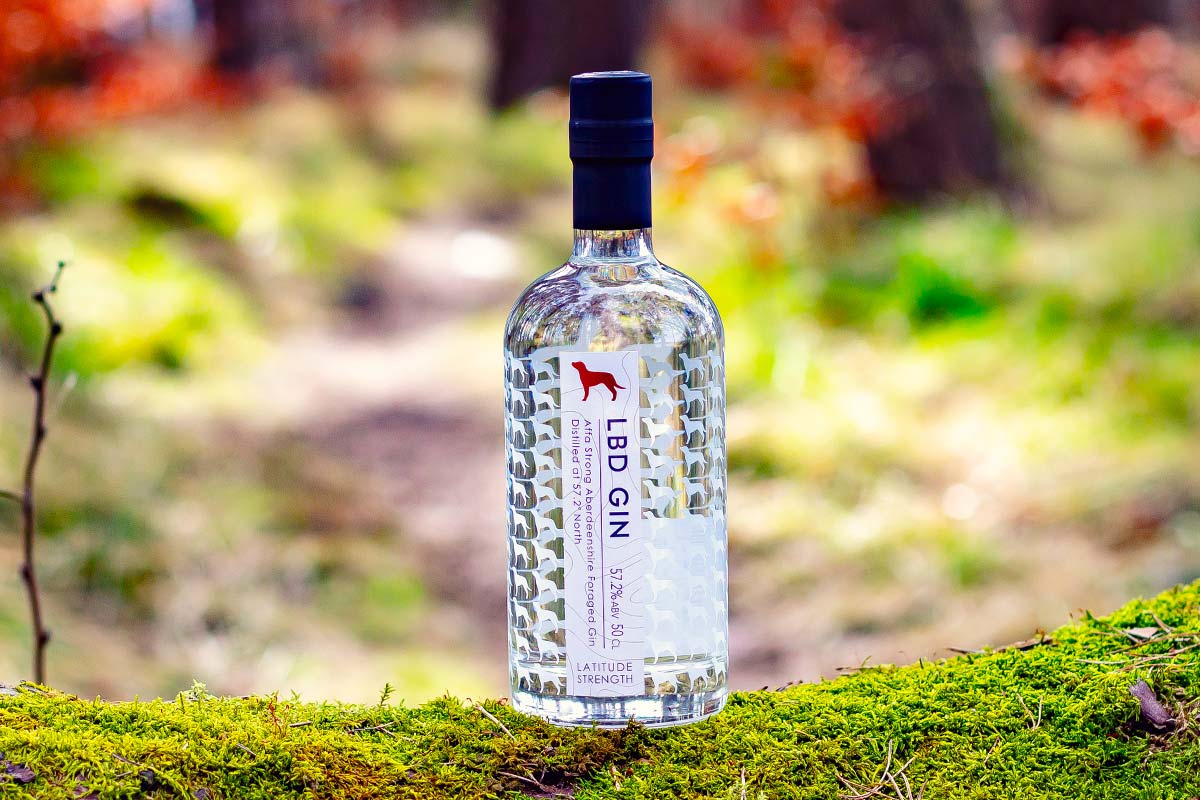
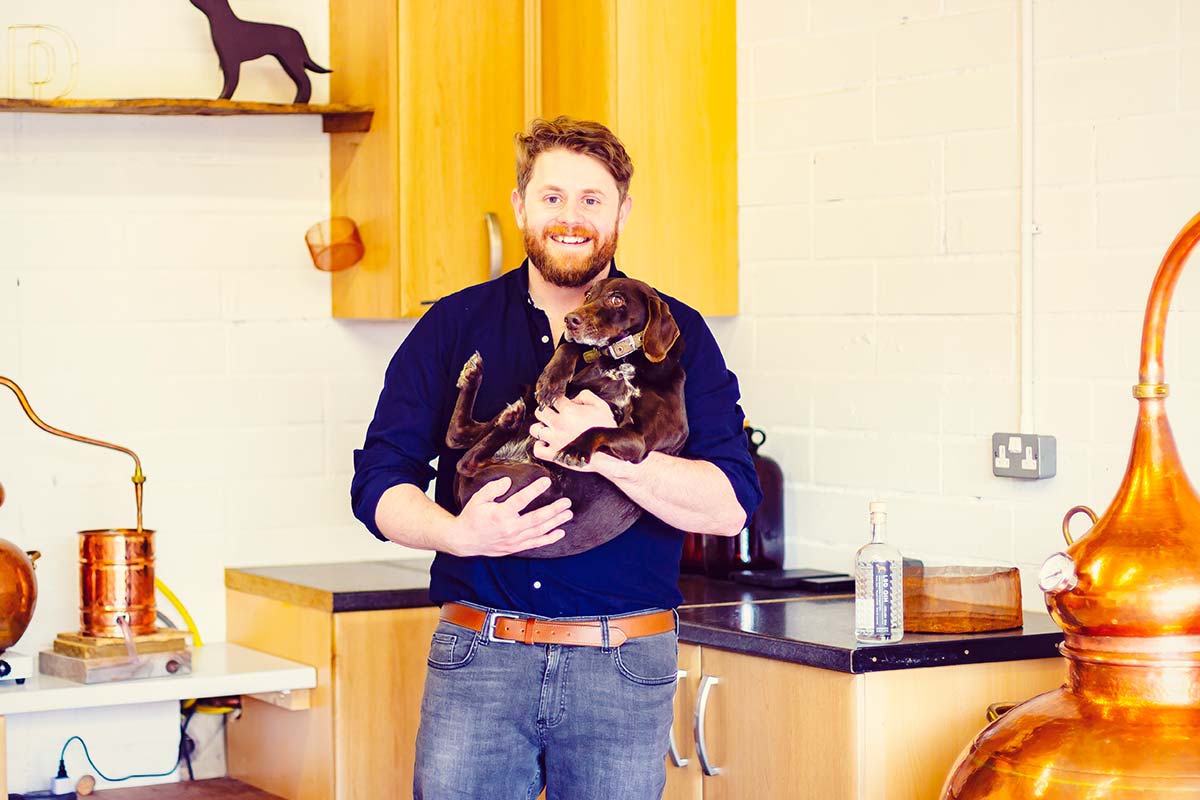
“We’ve always thought our LBD GIN really sang at higher ABVs. Just lifting the lid off the tank and taking a sniff before reducing it, we wanted to recreate that experience for folk who enjoy our gin. It’s called latitude strength because we distil at 57.2° North so it’s 57.2% ABV, which is a whole 0.2% ABV higher than a navy strength and therefore better. We’ve always geo tagged our foraged and grown ingredients for LBD Gin so it felt like the right thing to match ABV to latitude.”
Andrew Smith, Co-Founder and Distiller, Little Brown Dog Distillery
Learn more about Little Brown Dog Spirits here.
Mackintosh Mariner Strength Gin (59% ABV), Distilutions
Jim and Deborah Macintosh launched their signature Mackintosh Scottish Gin in 2018. The couple saw an opportunity to create a gin that appealed to them as gin drinkers with juniper and citrus at heart. Deborah had been enjoying more and more craft gins but kept looking for that elusive gin that hit all the right notes. As much as it would have been fun to keep searching, tasting, exploring and enjoying the ever-growing range of gins available, naturally the best solution was to create her own gin!
Thanks in part to Deborah’s love of the juniper spirit, Jim, who was a long time whisky drinker, also began to discover the diversity of the gin category. With an idea of what they believed would make a great gin, the couple sought the support of award-winning distiller Lewis Scothern at Distillations in Arbroath. Also being Angus based, Jim and Debs set to work with Lewis at the distillery testing a number of recipes. Being involved in the development process allowed the couple to see, taste and smell each recipe, refining until they not only had a gin that they felt was what they were looking for in a gin but that they were proud to call their own.
Working so closely with Lewis provided the couple with an ‘in at the deep end’ experience and insight into the production process. From recipe development and the technical side of the distillation process, but also the not so glamorous side with filling, bottling, labelling, all done by the hand by the family between the distillery and home. It does, however, help when you have a family who loves a challenge, and with the help of their three daughters and their partners, the Mackintosh gin brand has continued to grow with the addition of their Mackintosh Old Tom, which was named gin of the year at the Scottish Gin Awards 2020, but also their Mackintosh Mariner Strength Gin, which also picked up a silver in the High Strength Gin of the Year category.
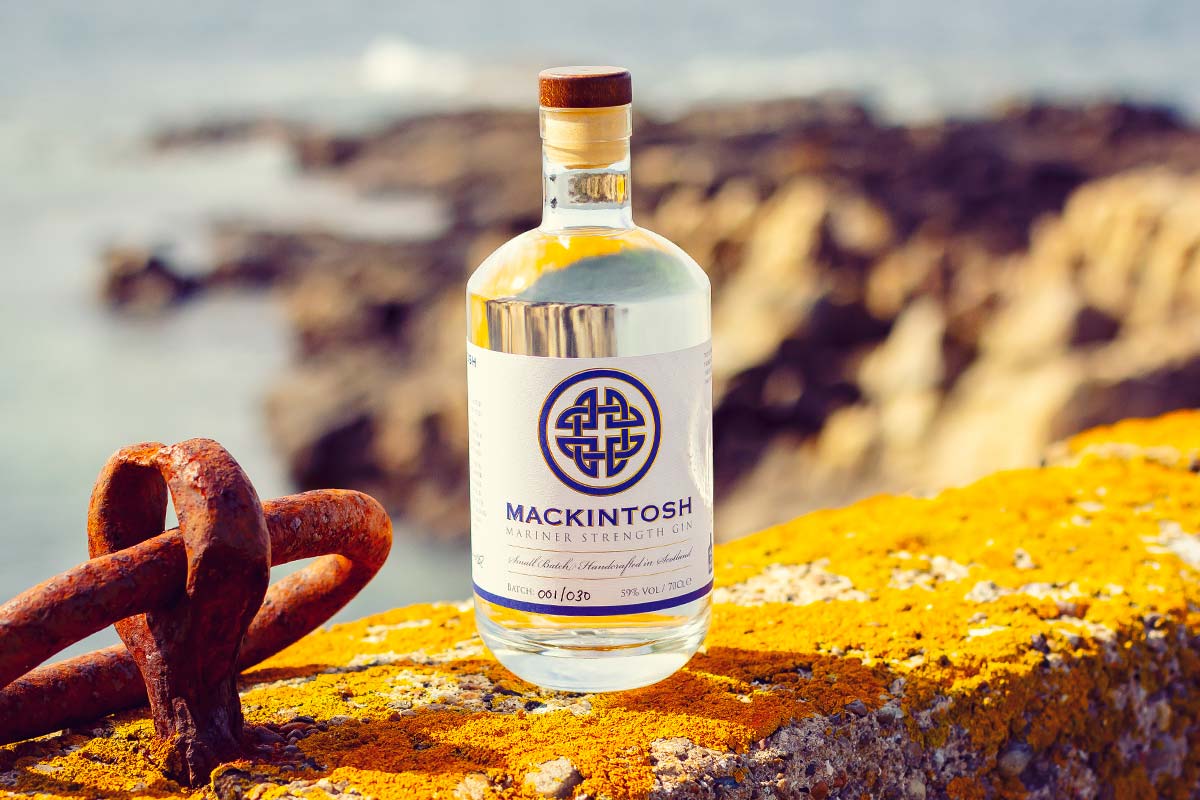
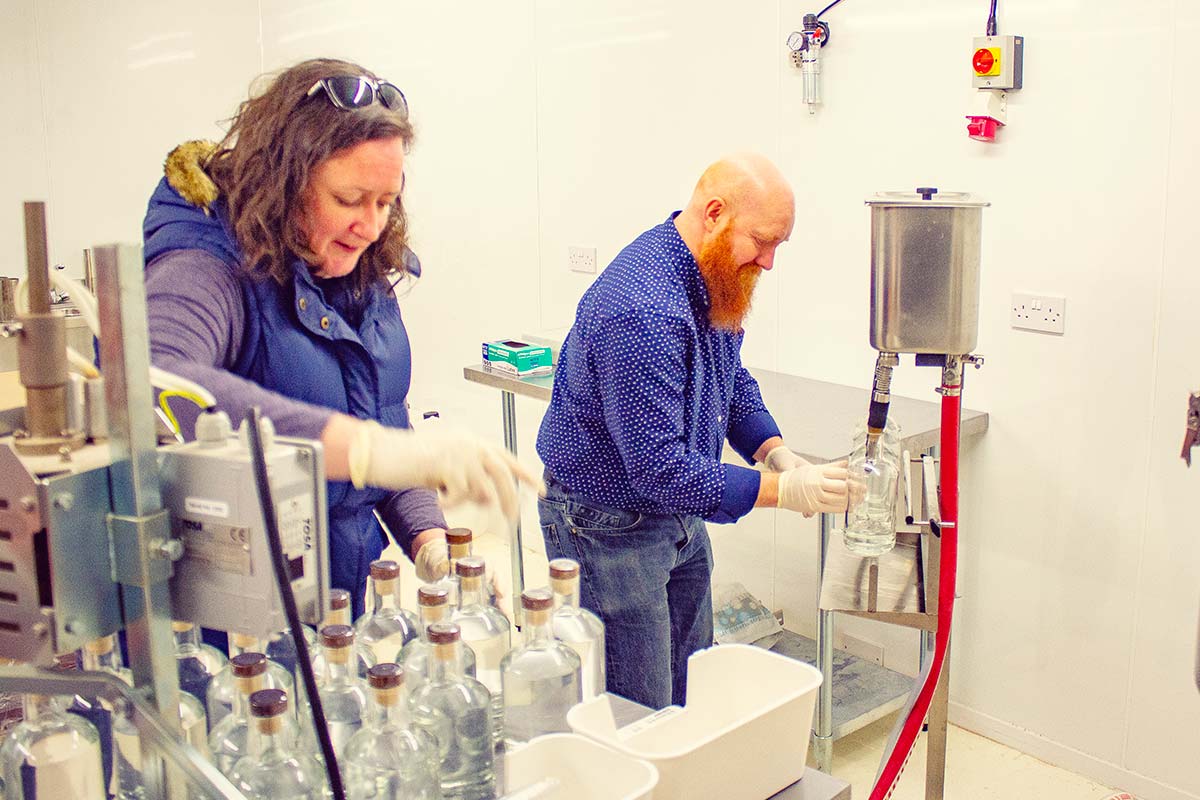
“Bottled at 59% ABV, Mackintosh Mariner Strength Gin is distilled using nine botanicals. Based around our award-winning Mackintosh London Dry recipe, botanicals include juniper and classic Mediterranean citrus fruits along with locally foraged elderflower. The result is an ‘upfront and centre’ juniper-led spirit with floral hints of elderflower and citrus notes of orange and lemon. With its higher ABV, the botanicals are emphasised on the palate.
“Our London Dry is a smooth gin, which at 42% is a good ABV for this style. We knew with such a high-quality spirit to start from, that at a higher strength, with some tweaking to the botanicals, we could produce an equally smooth high quality higher strength spirit that could be enjoyed in many ways. This gin can be enjoyed as a sipping gin, neat over ice, in a G&T where the oils from the botanicals can be seen by the liquid becoming opaque in appearance. Additionally, it can also be used in cocktails with the flavour of the gin not being lost by the other ingredients. The Mariner Strength is Deborah’s favourite of our three expressions, and when partaking in a G&T has a 1 to 3 ratio served with tonic, lemon or lime and lots of ice.”
Jim Mackintosh, Co-Founder, Mackintosh Gin
Learn more about Mackintosh Gin here.
Badachro Gin 57° Storm Strength Gin (57%ABV), Badachro Distillery
Based in the former fishing village in the north-west Highlands of Scotland of Badachro, Gordon and Vanessa Quinn have been making gin at their distillery since 2017; producing gins that encompass a sense of place through flavour, packaging and their own passion for the local area. Originally meeting on holiday in Badachro, the small village left a lasting mark on the couple who eventually married, travelled the world and moved to Badachro with their young family, where they established their distillery along with their family B&B, which overlooks the bay and the village.
It’s thanks in part to its geographical location on the West Coast of Scotland in the Scottish Highlands, and no stranger to storms blowing in from the North Atlantic Ocean, that the distillery, being close to 57° latitude, they were inspired to create a high strength gin named 57° Storm Strength.
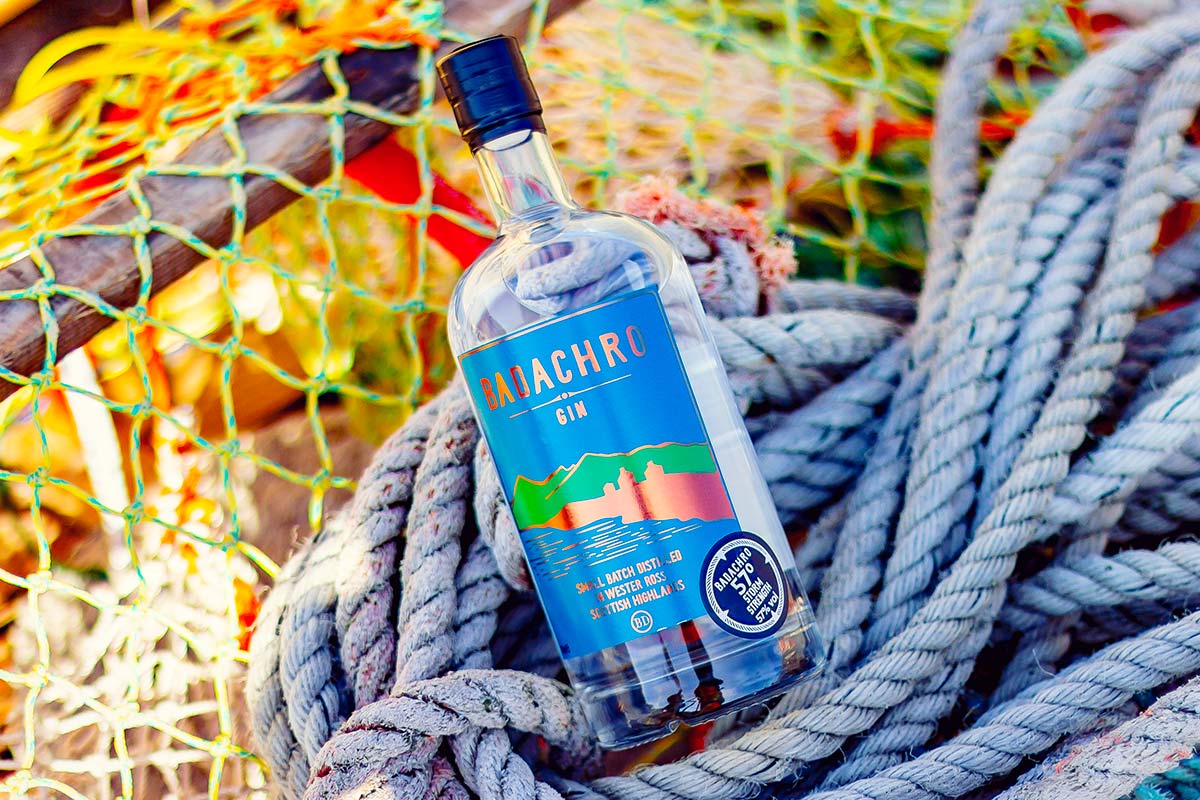
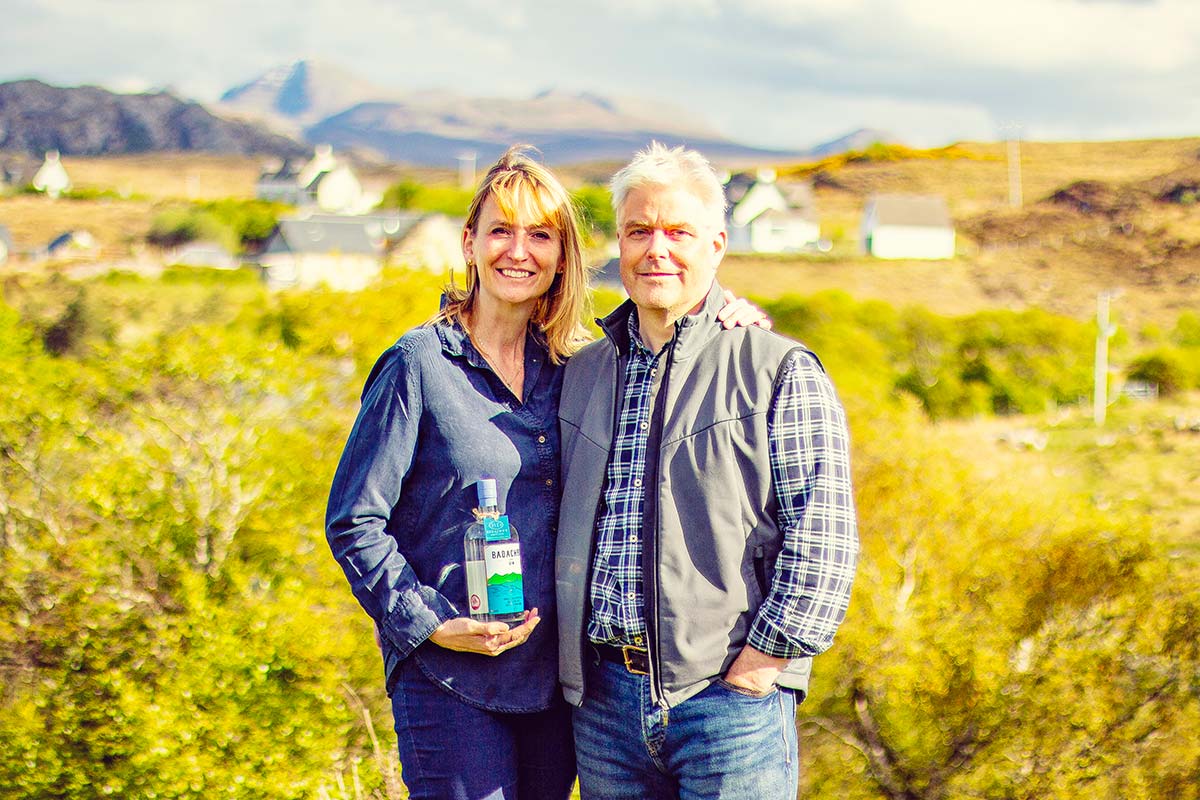
“Badachro 57° Storm Strength was the second gin we released simply because a trade customer asked for it! Most navy strength gins are just the still strength gin, cut with less water, so it remains stronger in alcohol. We tried this but found that we lost the trademark smoothness of Badachro Gin. So, we experimented on two fronts, trying out some botanicals that would potentially smoothen the flavour, and played with alternative ways of distilling.
“We ended up with a combination of both, adding more of a particular local botanical (which definitely helps round off the sharpness of a high strength spirit) and multi-shot distilled the gin, so we could vary the ratio of botanical oils to the alcohol strength, hence delivering a gin which has a higher percentage of oils than usual, which also helps soften the flavour. Ironically, this results in our Storm Strength gin being ideal for a low alcohol strength G&T, as you can still get a high degree of flavour when cut with tonic to a lower alcohol strength drink.”
Gordon Quinn, Co-Founder and Distiller, Badachro Distillery
Learn more about Badachro Distillery here.
Pentland Hills Navy Strength Gin (57% ABV), Tarbraxus Distillery
What do you get when you combine lush, green hillsides, a husband, a wife and a family of labradors? Scottish Gin might be the last thing that comes to mind! But with retirement from a 30 plus year career in the RAF and the decision as a couple to rebalance work and life, husband and wife Phil and Tabatha decided in 2017, the time was right to make the change.
As long time gin drinkers, the idea to make gin came to them on a quiet summer’s evening, whilst enjoying a few G&T’s naturally, pondering what the future held and discussing their desire to do something they could both enjoy, and that would let them be creative and help them work from their beautiful rural location on the outskirts of the small village of Tarbraxus at the foot of the Pentland Hills in South Lanarkshire.
Panza, the official Pentland Hills Gin brand ambassador and mascot, provided the perfect inspiration for the brand and packaging, with every bottle hand engraved by Tabatha, featuring an etching of Panza walking through the Pentland Hills.
Pentland Hills Navy Strength Gin reflects all of the wonderful flavours of their original gin but with a bolder flavour and higher strength of 58% ABV. The design on the neck of the bottle features an emblem of a woman, which was, in fact, the emblem for HMS Electra. Tarbraxus Distillery co-founder and distiller Phil’s Grandfather served and died aboard the HMS Electra in 1942 in the Battle of Java Sea, so the design is a respectful nod to his family’s service. Fittingly, a percentage of sales from every bottle sold is donated to the Royal Navy Benevolent Trust, a charity close to the family’s heart.
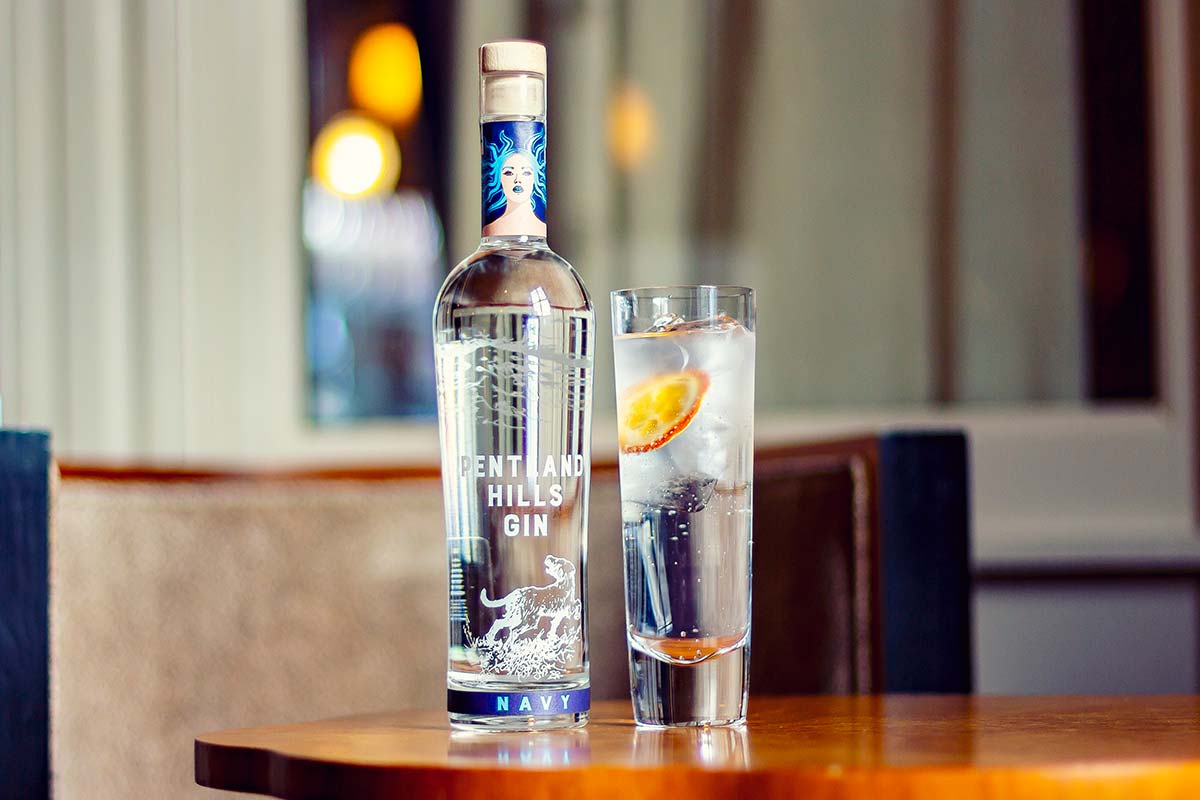
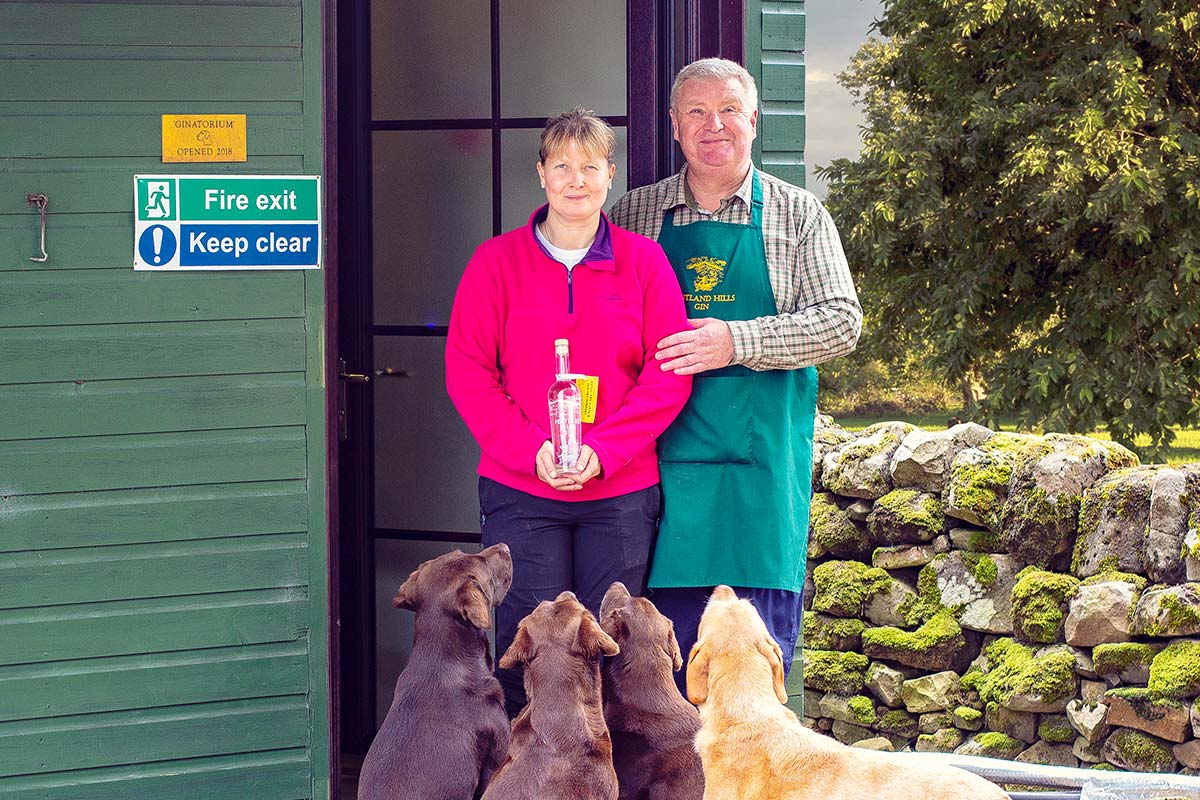
“Pentland Hills Navy Strength Gin was first released in July 2020. The gin is offered at 58% ABV and is double distilled to create a very smooth palate. The gin recently won a bronze medal at the World Gin Awards, and the tasting panel offered the following: ‘Bold menthol notes, with some salinity and a long finish. There are some floral notes and juniper on the nose, whilst the palate sees this juniper alongside fresh balsamic notes, menthol and lemon balm. Good balance.’ The gin is sublime as a G&T served with pink grapefruit and a garnish of mint, or for the more adventurous – mix a martini – you won’t be disappointed!”
Philip Cox, Co-Founder and Distiller, Tarbraxus Distillery
Learn more about Pentland Hills Gin here.
Rock Rose Navy Strength (58% ABV), Dunnet Bay Distillery
Established by husband and wife Martin and Claire Murray, Dunnet Bay Distillers, the distillery behind the Rock Rose Gin range of Scottish Gin expressions and Holy Grass vodka, released their first gin in 2014. Both originally from the Dunnet Bay area, which is located at the very north of Scotland on the coast, the couple have continued to grow their range of spirits as well as growing the reputation and reach of the brand, which can now be found in over 24 countries along with listings at some of the world’s most respected bars including ATLAS Bar in Singapore.
The couple have created a wonderful visitor experience at the distillery with a bespoke tasting room, tours and shop that stock the full range of Rock Rose Gin expressions and other locally produced gifts. Very much a working distillery and a hive of activity, the distillery in terms of production and size is modest but filled with charm and the love for what Claire and Martin do can be seen in abundance in all the details that they’ve put into not only their packaging, the care for producing great Scottish Gins but also helping create employment in the area as well as putting Dunnet Bay on the global distilling map. The distillery also picked up Distillery of the Year at the Scottish Gin Awards 2019.
Dunnet Bay Distillers were also the first distillery in Scottish Gin to introduce the concept of refill pouches, which means customers can order a fully recyclable pouch of their favourite Rock Rose Gin expression, top-up their original stoneware bottle and simply pop the empty pouch in the post back to the distillery. From here, it’s sent off to the pouch manufacturer, where’s it recycled to create a new pouch.
Since 2014, every year has seen the distillery continue to grow in terms of sales, reach and popularity. It’s thanks in part to the popularity and success of their signature Rock Rose Original Gin that inspired the creation of Rock Rose Navy Strength Gin.
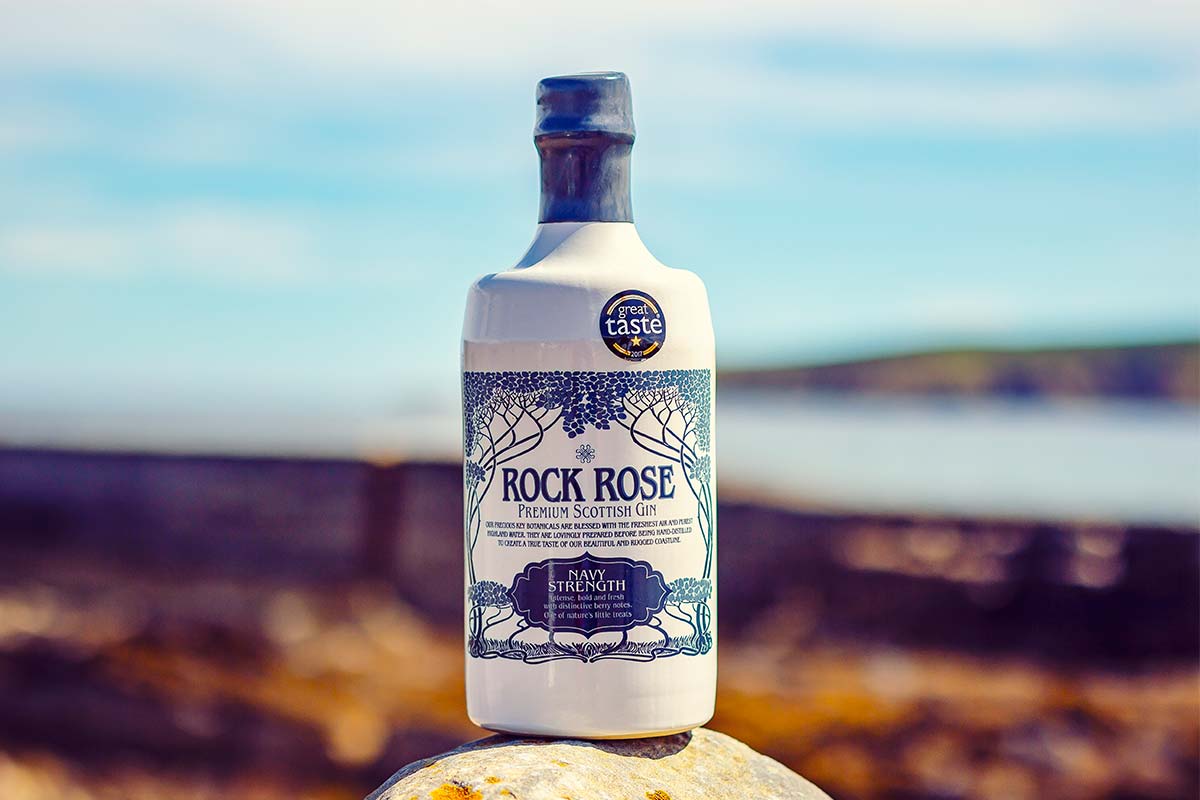

“Our Navy Strength came about because bartenders had asked us for a stronger version of Rock Rose for cocktails. I trialled a Navy Strength and made a Negroni, and that made my mind up for me! It’s the same botanicals as Rock Rose, but the higher ABV brings a punchier juniper-forward gin with a lot more spice than the original edition. This comes from the cinnamon, cassia and grain of paradise.”
Martin Murray, Co-Founder and Distiller, Dunnet Bay Distillers
Learn more about Dunnet Bay Distillers here.
Farmer Strength Drovers Gin (57% ABV), The Wee Farm Distillery
Based in South Lanarkshire, The Wee Farm Distillery overlooks the rolling green pastures, hillsides and rich agricultural landscape of the surrounding area. Based on a working farm owned and operated by the McKerr family, Jenny and her family are slowly and carefully building something very, very special for gin drinkers and foodies alike.
The McKerr family recently completed another step in their plans for the farm with the refurbishment, renovation and transformation of one of the farm buildings into ‘The Distillers Cottage’. It sleeps up to six people and comes with a wood-burning stove, private garden and hot tub where guests can enjoy a Drovers Gin G&T along with various activities on-site, including a private tour of the distillery and tasting.
Along with a distillery, The Distillers Cottage accommodation, Jenny is slowly growing her beef herd encompassing a number of breeds, including Aberdeen Angus along with sheep. There are lots of plans for the farm, including orchards and more, with the aim of growing crops, fruit and botanicals that can feature in future The Wee Farm Distillery Gin expressions and spirits.
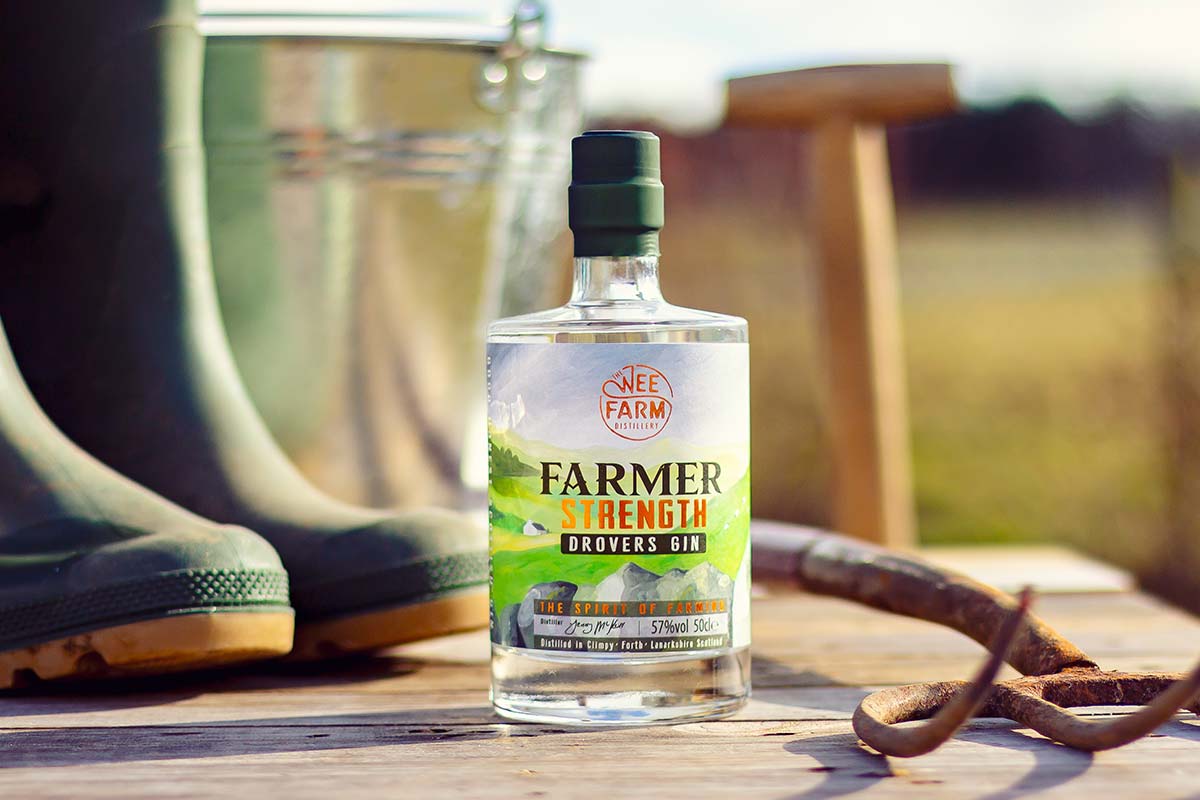
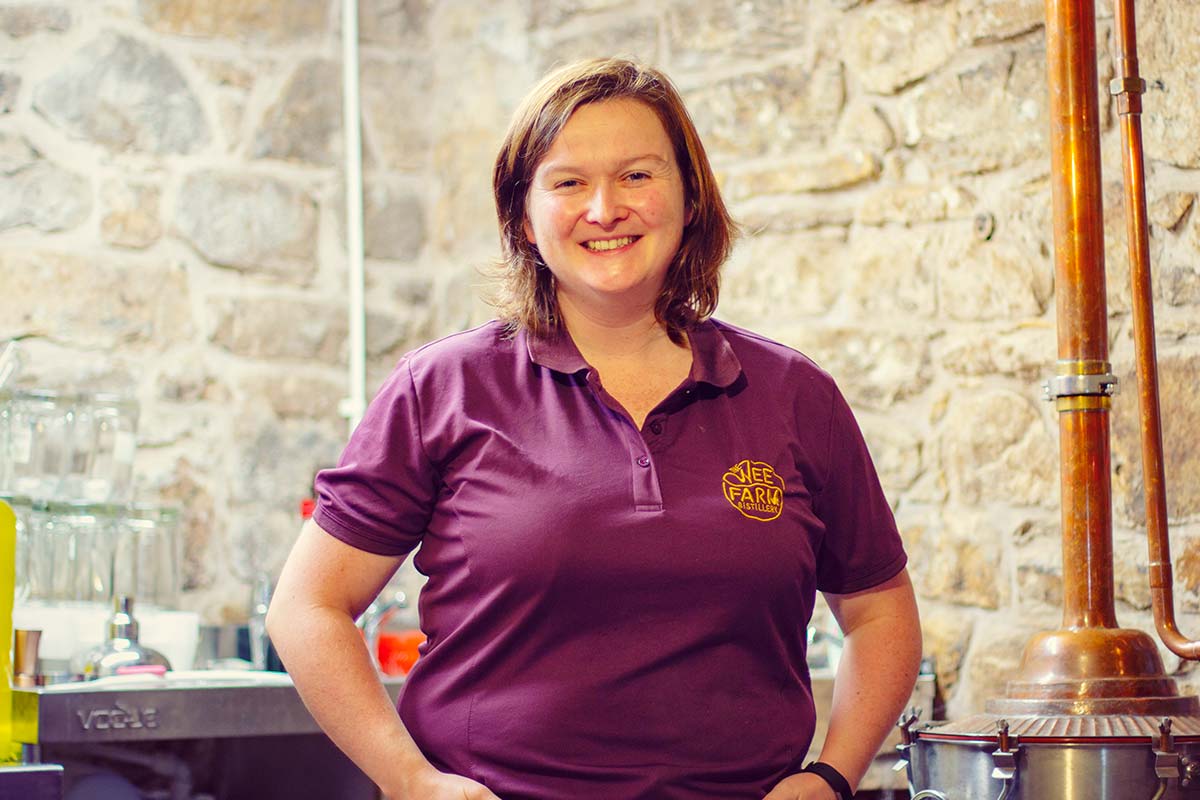
“I wanted to create a Navy Strength ABV gin but put our own twist on, with our distillery here on the farm and my farming and food background, Farmer’s Strength Drovers Gin is full of flavour. We distil with 13 botanicals, including classic gin botanicals and juniper, and a combination of pink peppercorn, allspice, wild heather and thistle. The result is a citrus and spice flavour profile that, just like our signature Drovers gin, complements dishes with red meat.
“It’s something we believe is yet to be fully explored to its full potential is gin and food pairings. With Scotland’s reputation for producing world-class food, we’re very excited to see more of Scotland’s chefs exploring opportunities for Scottish Gin and food pairings, along with seeing more Scottish gin used in dishes. With the growing trend for agri-food tourism, Scotland is well placed with our landscape, amazing food and drinks producers, reputation for hospitality – all adding up to a few reasons why people looking for food and drink experiences should put Scotland at the top of their list of places to visit.
“As a business, a distillery, a farm, we also look at ways of collaborating and working with other like-minded businesses and people in the local area. That’s part of the reason why we chose a wonderful painting of the area by Strathaven based artist Anne Anderson to feature on the label, it captures the landscape and the farming way of life, a way of life we’re proud to be part of. I’m very proud and excited we’ve been able to diversify and explore new ways of bringing our local area to consumers through our Scottish Gins and spirits.”
Jenny McKerr, Founder and Distiller, The Wee Farm Distillery
Learn more about The Wee Farm Distillery here.
1881 Honours Navy Strength Gin (57% ABV), 1881 Distillery and Gin School
Based in the Peebles Hydro Hotel in Peebles, in the Scottish Borders, the 1881 range of Scottish Gin expressions was launched in 2019. Each of the four expressions takes its inspiration from the hotel’s history. It was originally built in 1881 and quickly became a local landmark sitting on Venlaw Hill overlooking the small market town of Peebles. The Peebles Hydropathic Establishment, as it was once known, was a must-visit for the Victorians offering therapeutic water treatments using water from the local freshwater spring. Seen as a potential cure for a number of ailments and afflictions, visitors flocked to the hotel from across the UK. It’s the connection to the hotel’s hydropathic history that inspired the 1881 Gin.
In 1905, the hotel was left in cinders after a fire left nothing more than the foundation’s piles of smouldering stonework. But from the ashes, the new hotel was built and finished in1907 using some of the reclaimed materials from the fire. It was this incident that inspired the 1881 Rafters gin.
In the 1920’s, the popularity of tennis continued to grow, and sensing the opportunity to provide guests with the chance to enjoy this new past time, the hotel created a number of tennis courts for guests to enjoy. In fact, at one point, the hotel had more tennis courts than Wimbledon, which saw the Lawn Tennis Scottish Championships being held annually at the hotel during the 1930’s. It’s this era that inspired the 1881 Pink Pavillion Gin. It was also here that many visitors could enjoy a Pimms or a G&T and watch the play unfold.
1939 was the start of World War 2, and like many large hotels and establishments at the time, the hotel was requisitioned by the MOD as a Military General Hospital. The hotel, with its 1,200 beds, helped injured personnel recover and it wasn’t until August 1946 that the hotel was able to re-open it’s doors. It’s this time in the history of the hotel that provided the inspiration for the 1881 Honours Navy Strength Gin.
Fast forward to the present day and the hotel now features both the distillery and a must-visit gin school where visitors can enjoy making their own gin on one of the twenty eight mini copper stills along with learning more about each gin and the history of the hotel, 1881 cocktails and more.
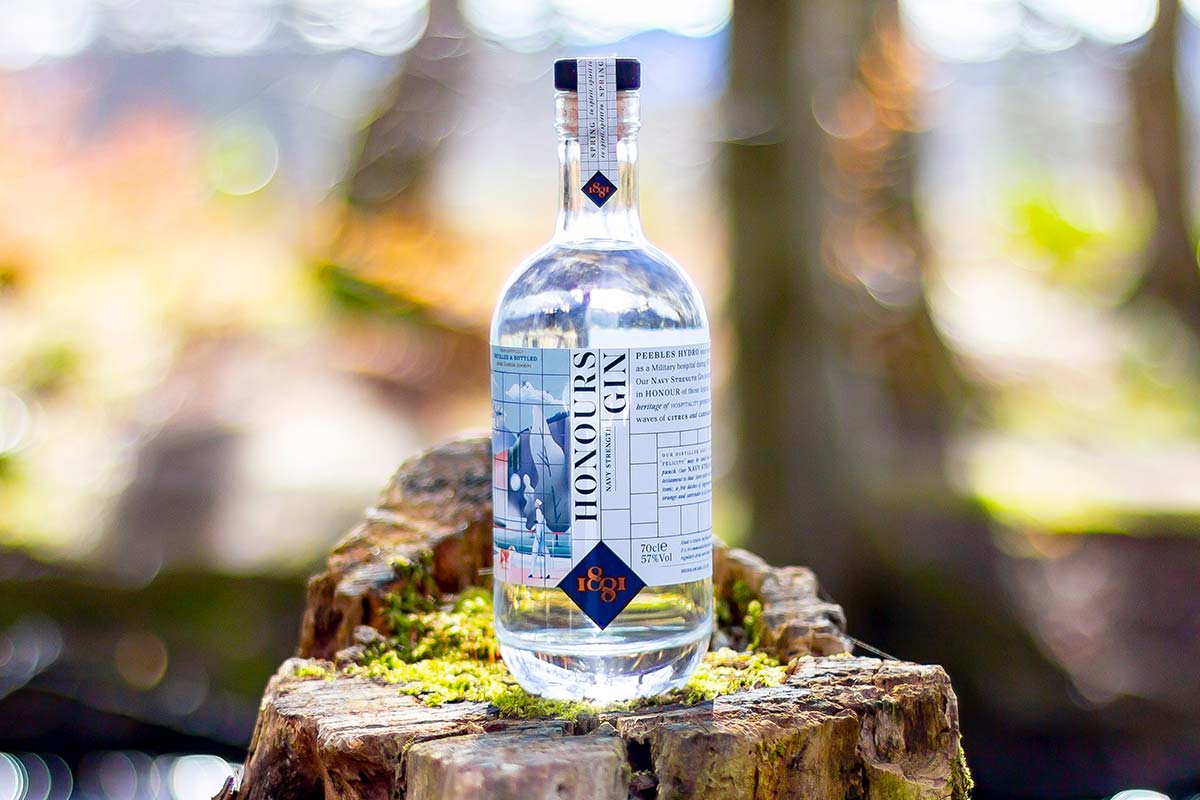
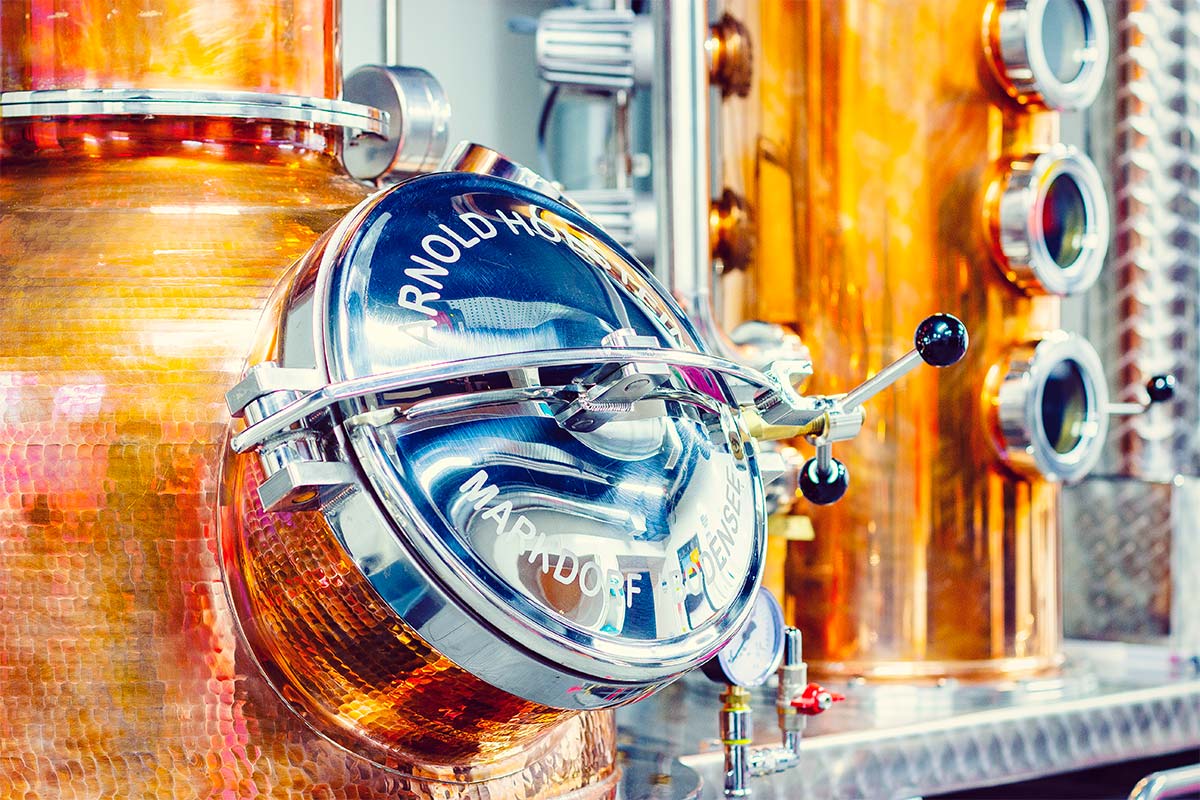
“1881 Honours Navy Strength Gin is a celebration of our building’s history, memorialising the use of our grounds and hotel as a military hospital during WWII as a place of respite and healing – a legacy we hope to preserve every day. Honours is produced on our 150L copper still “Felicity” using the spring water that gave Peebles Hydro its location and 12 botanicals which provide this smooth 57% gin with waves of citrus and cardamom aroma and flavour. We would recommend serving Honours with a few dashes of aromatic bitters and a slice of orange. Irresistible.”
Dean McDonald, Head Distiller, 1881 Distillery and Gin School
Learn more about 1881 Distillery here.
Edinburgh Gin Cannonball Strength Gin (57.2% ABV), Edinburgh Gin Biscuit Factory Distillery
A brand that’s been at the forefront of the Scottish Gin category since its original launch in 2010, before moving distillation to Scotland’s capital city of Edinburgh, Edinburgh Gin has continued to grow as a brand and its range of expressions. With two distilleries across Edinburgh, the West End distillery is located at the end of the world-famous Princess Street. Blink and you’ll miss it though as the West End distillery is located in the basement of the Heads and Tails bar and is home to two gin stills, Flora and Caledonia.
The main distillery is located in the Biscuit Factory in Leith, and is home to 1000 litre custom copper still Gin Jeanie. Being based in Edinburgh has not only inspired the brand but also greatly influenced the Scottish Gin expressions produced at both distilleries. Seaside takes its influences from the nearby coast, whilst the 1670 Edinburgh Gin was created in collaboration with the Edinburgh Royal Botanic Garden.
With its long historical maritime and naval links, as well as the famous One O’clock Gun, a cannon that’s fired every day at Edinburgh Castle at 1pm, Edinburgh Gin Cannonball Strength Gin incorporates all these elements into the gin. With double the juniper of the classic Edinburgh Gin, the gin strongly and confidently holds its own in any number of gin-based cocktails. Edinburgh Gin Cannonball Strength Gin was amongst the first of the high strength Navy Strength gins to appear in the Scottish Gin category and has continued to pick up a number of awards since its original launch in 2015.
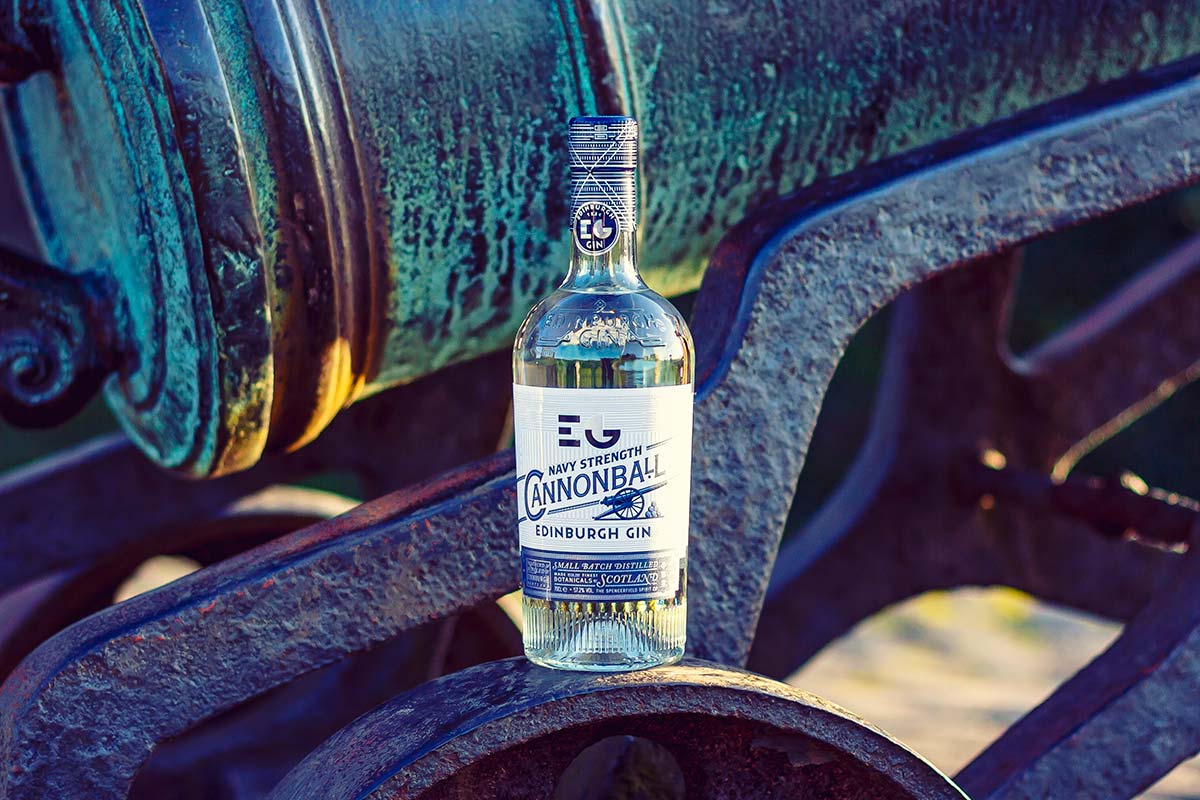
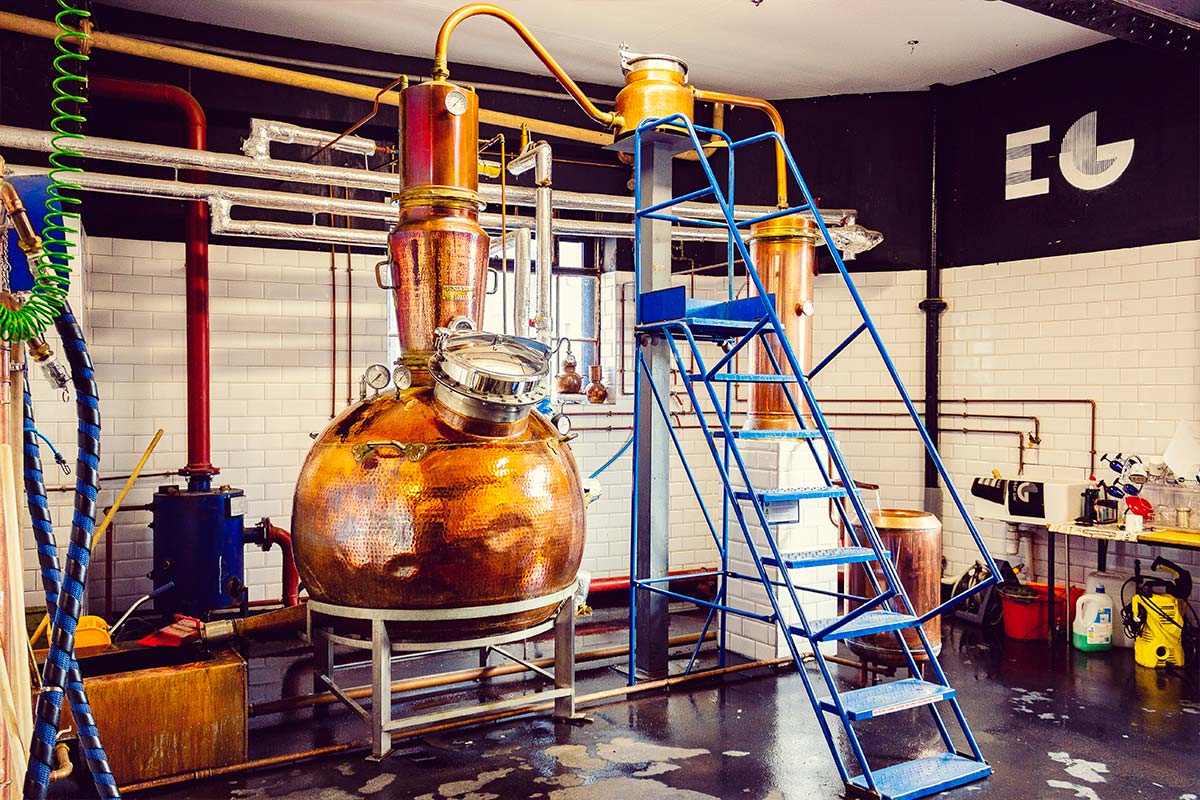
“Back in 2015, there were very few Navy Strength gins about. Cannonball was spawned from the fact that we really enjoyed drinking cask strength spirits, especially whisky. We wanted to make a Navy Strength gin that really stood out and didn’t just dissipate on the palate. Essentially, we wanted to make a gin with real length and a proper finish. We realised just diluting Classic Edinburgh Gin less wasn’t the solution to this, so we set out to create a brand-new recipe based around loads of Tuscan juniper, Szechuan pepper and citrus.
“The Tuscan juniper is big, rich, resinous and spicy and really coats the mouth with oils, the Szechuan pepper contains not only aromatic warmth but also a molecule called Hydroxy-alpha sanshool which gives the mouth a warm tingling sensation. We balanced that all out with a good hit of lemon (which has since been replaced by yuzu). The result was Cannonball, which achieved everything we set out to do and went on to win gold at the IWSC the following year. And finally, it’s worth noting it makes a banging Negroni as the gin can stand up to the Campari and Vermouth. And its still the best Martini I’ve ever had.”
David Wilkinson, Head Distiller, Edinburgh Gin
Learn more about Edinburgh Gin here.
Tarbert Legbiter Navy Strength Gin (57% ABV), Beinn an Tuirc Distillery
Known for its whisky thanks to a new wave of distilleries and lost distilleries that no longer exist or have shut over the years, Campbeltown and the local area is synonymous in the world of whisky. Just a short drive from Campbeltown is the Torrisdale Estate where you’ll discover not only a castle but Beinn an Tuirc Distillery.
Established in 2016 by brothers Niall and Kenny Macalister Hall and Niall’s wife Emma, the distillery produces a variety of gin expressions along with other spirits, sustainability produced using the estate’s hydro-electric scheme with the signature Kintyre Gin launched in 2017. The distillery uses the water that flows from the Beinn an Tuirc hillside, which translates from Gaelic as ‘The Hill of the Wild Boar’, in reference to the once abundant wild boar that lived across Kintyre and other parts of Scotland.
Along with distillery tours, the Beinn an Tuirc Distillery also now features their recently opened gin school where visitors can create their own bespoke gin using one of a number of carefully created distillates that can be blended to create your perfect Scottish Gin from the hill of the wild boar. Steeped in history, it’s little wonder the Beinn an Tuirc team turned to local legends and folklore as the inspiration behind their aptly named Tarbert Legbiter Navy Strength Gin.
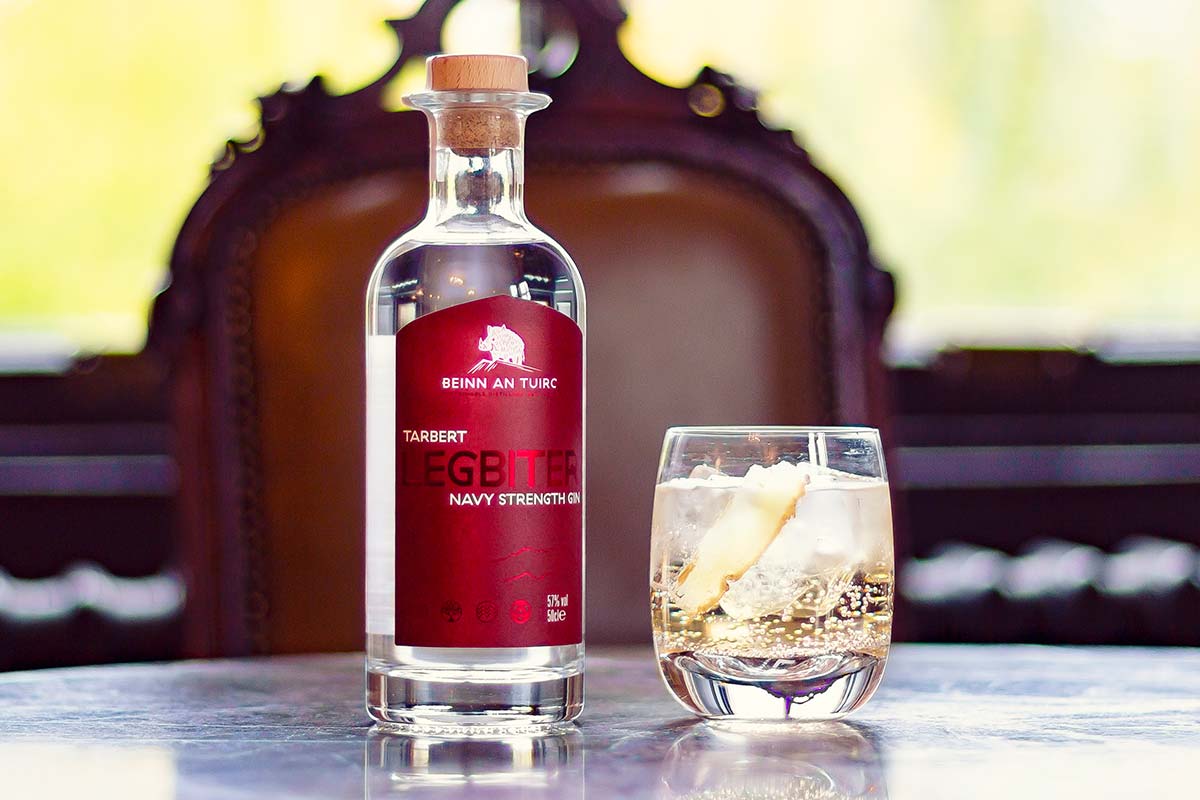
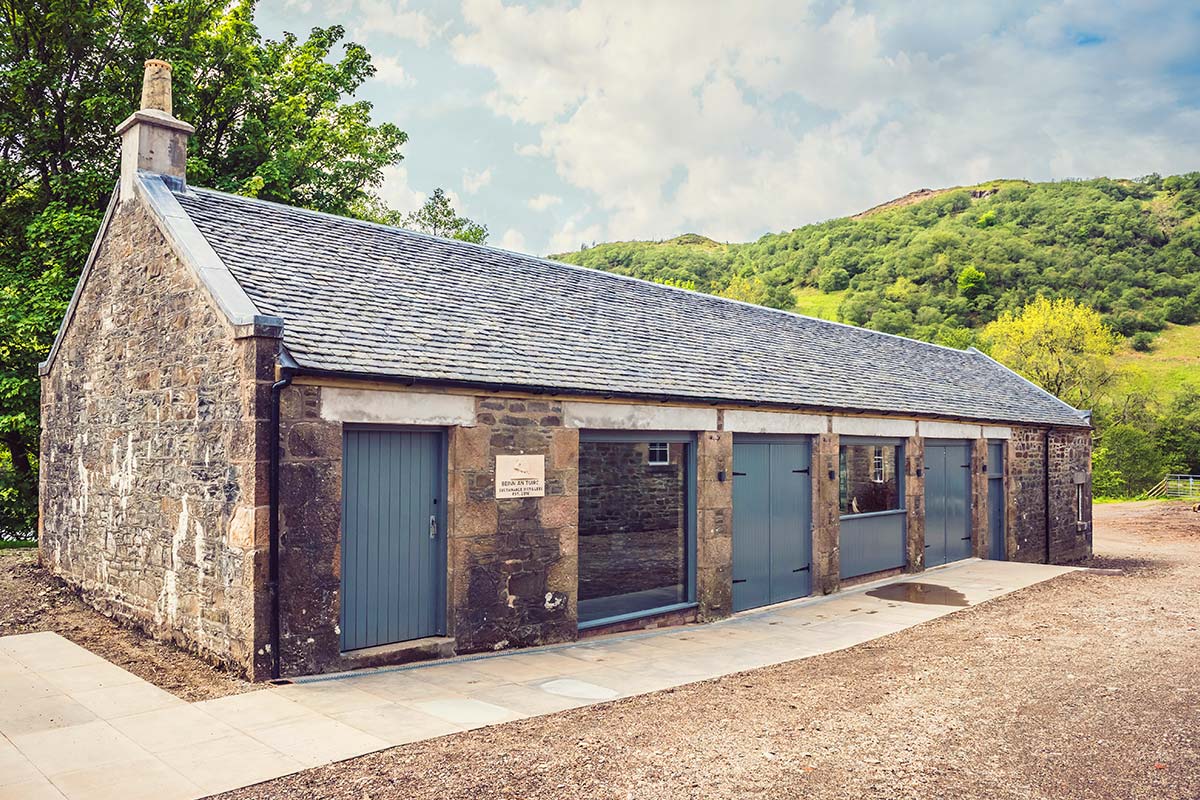
“Named for the sword of Viking legend, Magnus Bare legs, Tarbert Legbiter is not for the faint of heart but don’t let the 57% ABV put you off. This aromatic spirit is wonderfully smooth and flavoursome with delicate floral notes on the nose, warming into gentle spice and pine aromas. Distilled with hibiscus flower and pink peppercorns, it is sweet and light on the palate with a floral midsection and a dry, lingering spice finish.
“At Beinn an Tuirc Distillers we’re committed to sustainable production and use our own hydroelectricity to power the gin still. Tarbert Legbiter is one of several quality, award-winning gins in our range. We wanted to create a brand new spirit designed specifically for high strength – rather than use an existing gin and simply make it stronger. Our talented distillers have created something truly memorable and worthy of the Legbiter moniker.
“Tarbert Legbiter conquered the Scottish Gin Awards last year, picking up gold in the High Strength Gin category. Magnus Barelegs would be proud!”
Emma Mcallister Hall, Co-Founder, Beinn an Tuirc Distillers
Learn more about Beinn an Tuirc here.
Biggar Strength Gin (57% ABV), Biggar Gin Distillery
Originally made with the support of the team at the award-winning Strathearn Distillery, the co-founders of Biggar Gin, brothers Stuart and Euan McVicar brought their distillation back to their home town of Biggar in 2020 after completing the final stages of building their own distillery. A testament to their tagline on their website Biggar Gin, Biggar mentality.
The brothers’ original Biggar Gin was released in 2018 and went onto to win The Gin Guide 2018 Award for best London Dry Gin, the industry awards from the team behind The Gin Guide. Produced in batches of 200, Biggar Gin was well-received as having a classic, botanical rich flavour profile that put juniper, citrus and spice centre stage. The packaging for the bottle was also a talking point with its clever wrap-around label that meant when two bottles were placed side by side the labels combined to create the word ‘Biggar’. Subtle and clever. Biggar mentality in action.
A slightly different recipe to the signature Biggar Gin, Biggar Strength Gin keeps some of the original key botanicals including juniper, hawthorn berries and pink peppercorns but with the higher ABV really amplifies the flavours, creating a robust Navy Strength Scottish Gin that can help complement and balance bolder flavours, especially in rich cocktails or quinine rich tonics.
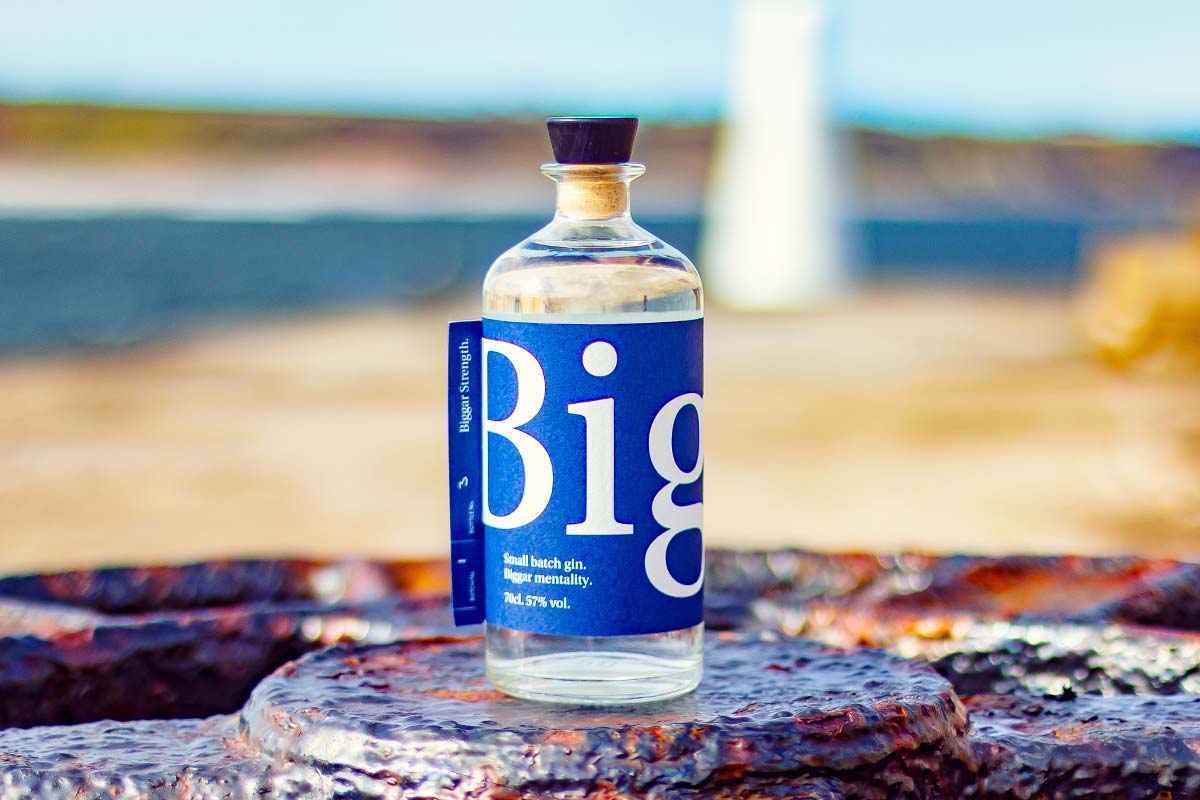
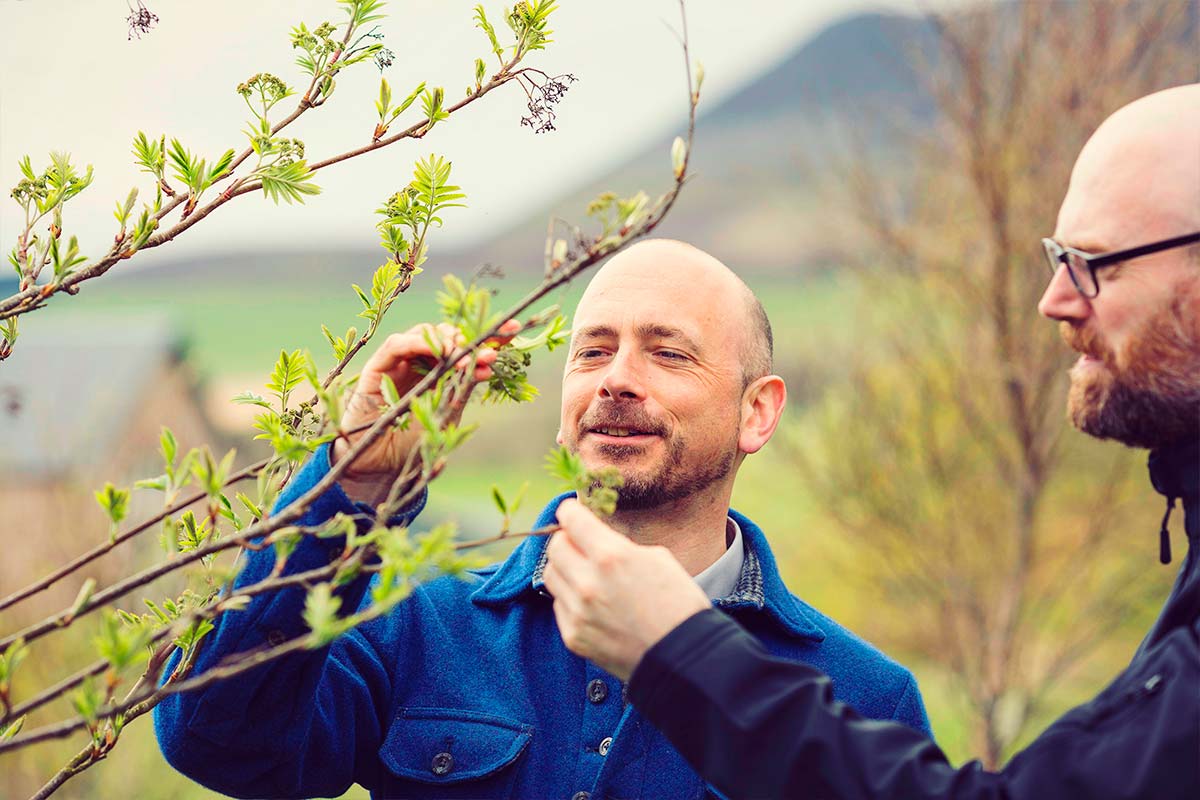
“A Navy Strength addition was always something we had in mind, but we wanted to take our time to get a version that was recognisably Biggar but which had a twist to it. A good navy strength gin works so well in classic gin cocktails, but they’re also plenty of discerning gin drinkers who much prefer a G&T, which packs a bit more of a punch.
“Biggar is about as far from the sea as it is possible to get in central Scotland, so giving this gin a maritime or naval name just didn’t feel right. That’s why we have quite simply called it Biggar Strength. That recognises its higher ABV but also the spirit of a town that consistently punches above its weight. We give a nod to the naval origins of these higher strength gins in the crisp, neat, navy blue and white label on the bottle.
“Our Original Recipe London Dry Gin relies on 3 local botanicals (rowan berry, rosehip and nettles) all of which we grow here at Biggar Gin HQ. For Biggar Strength, we wanted to draw on an additional local botanical we could find in our existing woodland. We had a number of choices but finally went with the hawthorn berry. The hawthorn berry has traditionally been used to flavour brandy but we felt sure it had something to add to gin. The berries if juiced are not dissimilar to cranberry in flavour and in dried form have a hint of apple. Distilled, you can pick up on that fruitiness but with an underlying tartness.
“It’s a nice coincidence that the botanical name for Hawthorn is Crataegus, derived from the Greek Kratos, which means strength. The ancient Greeks prized the wood of the hawthorn tree for its strength. We prize its berries for the flavour they give our navy strength gin.”
Stuart McVicar, Co-Founder and Distiller, Biggar Gin
Learn more about The Bigger Gin Co. here.
Seven Crofts Fisherman’s Strength (57% ABV), Highland Liquor Company Distillery
From its initial launch in 2019, Seven Crofts Gin from Highland Liquor Company was hard to miss. With its elegant and eye-catching green gradient embossed bottle and elegant yet simple label and branding, it instantly made its mark as one to watch. Not only was it a bold move launching with a green bottle, especially as there’s one gin that’s famous for its green bottle, but to launch with a bespoke bottle was also a bold move. But just like a good book, never judge by its cover. Thankfully the contents of the bottle live up to, and for many exceed, expectations.
Based in the small highland village of Ullapool, the team behind Highland Liquor Company have continued on the local tradition of creativity. The village originally started life in 1788 as a fishing station on the shores of Loch Broom. From here the settlement grew to a village of seven crofts with each croft home to a specialist trade including a boat builder, a rope maker, a cooper, a blacksmith, a fish curer and a mason. It’s from this original settlement that Highland Liquor Company takes the inspiration for its name – Seven Crofts.
Seven Crofts Fisherman’s Strength once again is a nod to the distillery’s home town of Ullapool, with its fishing community and ties to the local loch and waterways. Bottled at 57% ABV and again presented in a stunning bespoke bottle featuring a rich coastal blue hue, the flavour profile is described as juniper-led with forest floor notes coming through and hints of ripe blueberry, cracked black pepper, pink pepper and a touch of spicy coriander.
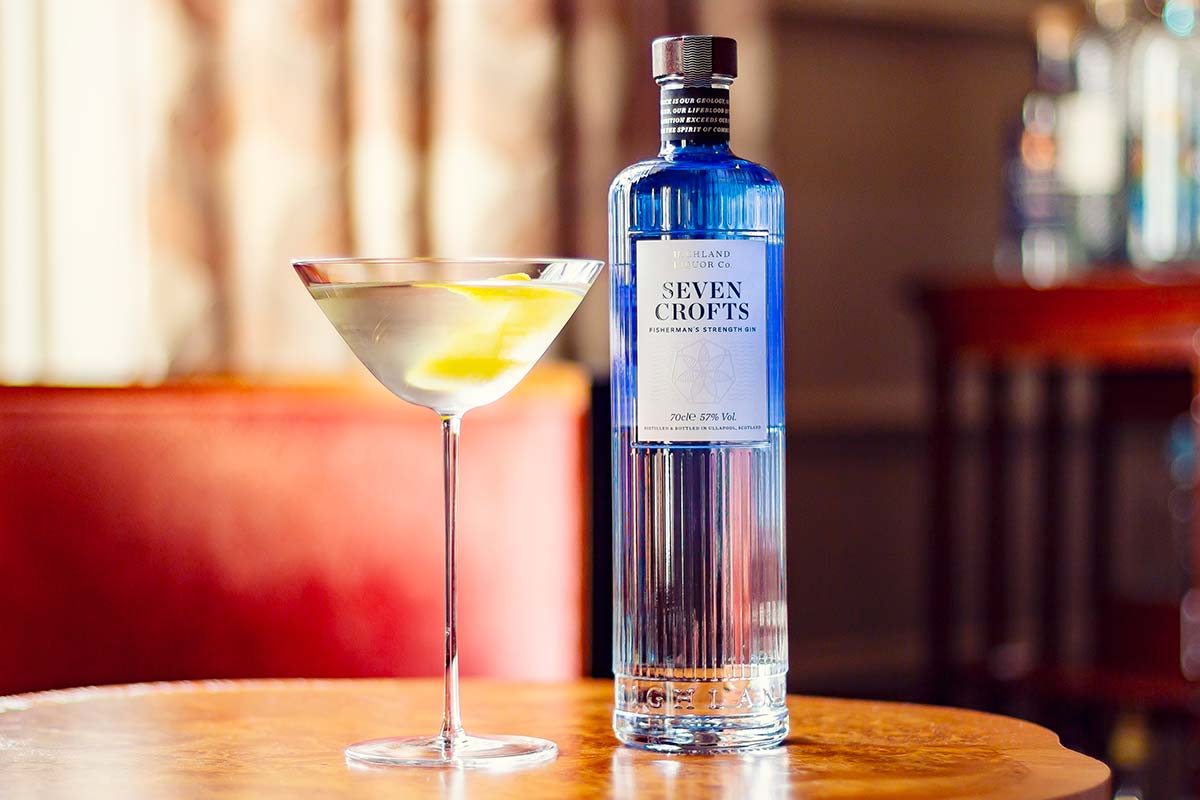
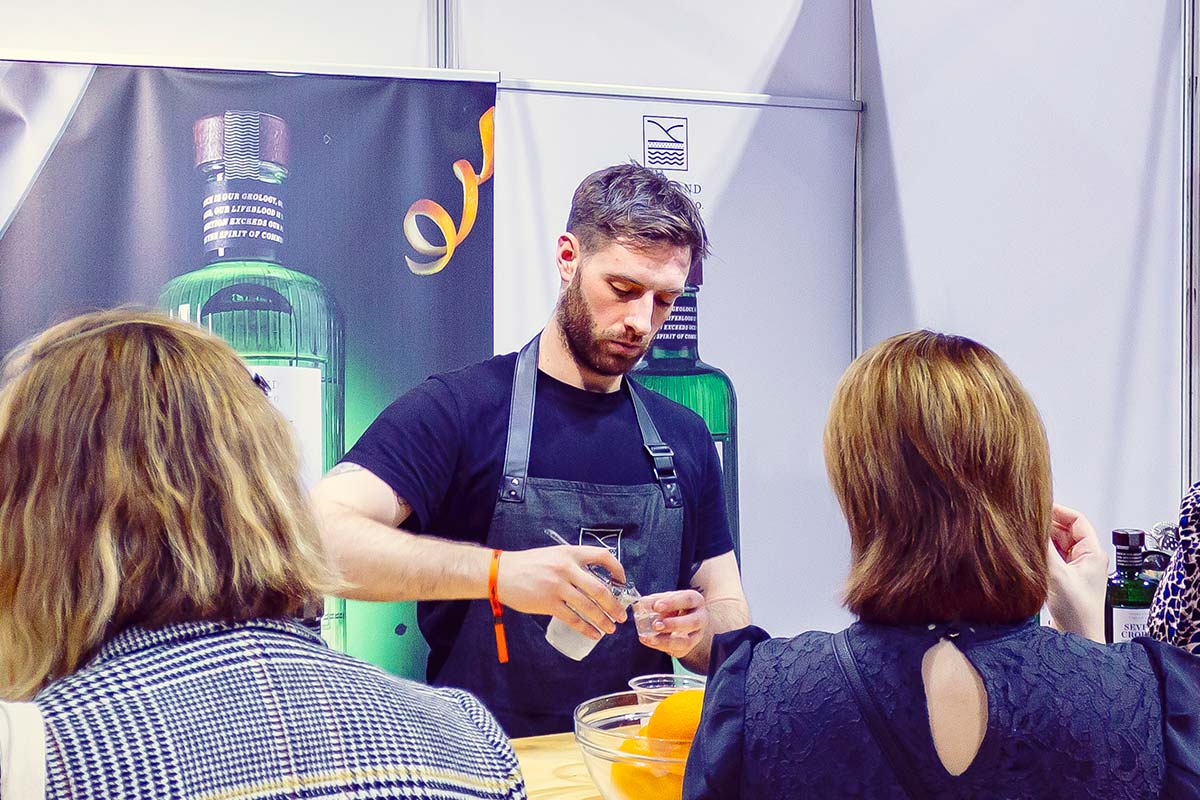
“We always viewed high-strength gins as a great way to elevate your spirit by creating a more premium offering that gives the consumer more ways to explore the product. In our case, we kept the backbone of our original Seven Crofts and bottled it a higher strength – to maintain the strength of the juniper pine notes and a more intense citrus element. Our goal was to create a spirit that could be enjoyed neat but also would stir into classic cocktails and gives bartenders a different flavour profile to experiment with.”
Louis Wright, Business Development Manager, Highland Liquor Company
Learn more about Highland Liquor Company here.
2019 Shetland Reel Up Helly Aa Gin (57% ABV), Saxa Vord Distillery
The Up Helly Aa festival is held every year on the island of Shetland in the capital of Lerwick, traditionally taking place on the last Tuesday in January every year. The festival sees islanders don Viking outfits and an army of Vikings marching through the streets of the town to the harbour front, where they torch a Viking longship.
A year in the planning, the Guizer Jarl, the leader of the Jarl squad of Vikings, and his squad begin their preparations in February when they start the creation of their outfits. In early September, the the remaining 46 squads begin their squad meetings and preparations. In total, the festival sees over a 1000 Vikings dressed in costumes that vary from the authentic to totally fun.
The works also begins on the building of longship at the end of September along with production of the torches. The festivities often begin during the day, but officially, the festival begins at 7.30pm when a signal rocket is sent sky high over the Town Hall before exploding to signal the beginning of the procession. Troches are lit and music begins as a snake of fire makes it way through the town led by the Guizer Jarl and his Jarl squad.
Once down at the harbour front, there awaits the Viking longship, which has taken four months of work to craft. Guizer Jarl boards the ship to cheers and chants before the squads with their torches begin to slowly circle the longship. A second rocket explodes overhead, signalling time for the Guizer Jarl is disembark before the flaming torches are thrown aboard and the ship goes up in flames. As it burns the crowd sings ‘The Norseman’s Home’, which is an ode to valiant Viking’s life at sea but also has a lot of sentimental meaning due to the centuries-old traditional fishing communities of the islands.
Over the next 24 hours, the squads of Vikings stop at various halls for refreshments, nourishment, laughter and chat with locals and visitors alike. And as is highlighted in the ‘Up Helly Aa’ song, every Viking has to dance with at least one lady in each hall. Each squad also performs a skit or act at each hall, which might be a sketch of some local events, a dance or song.
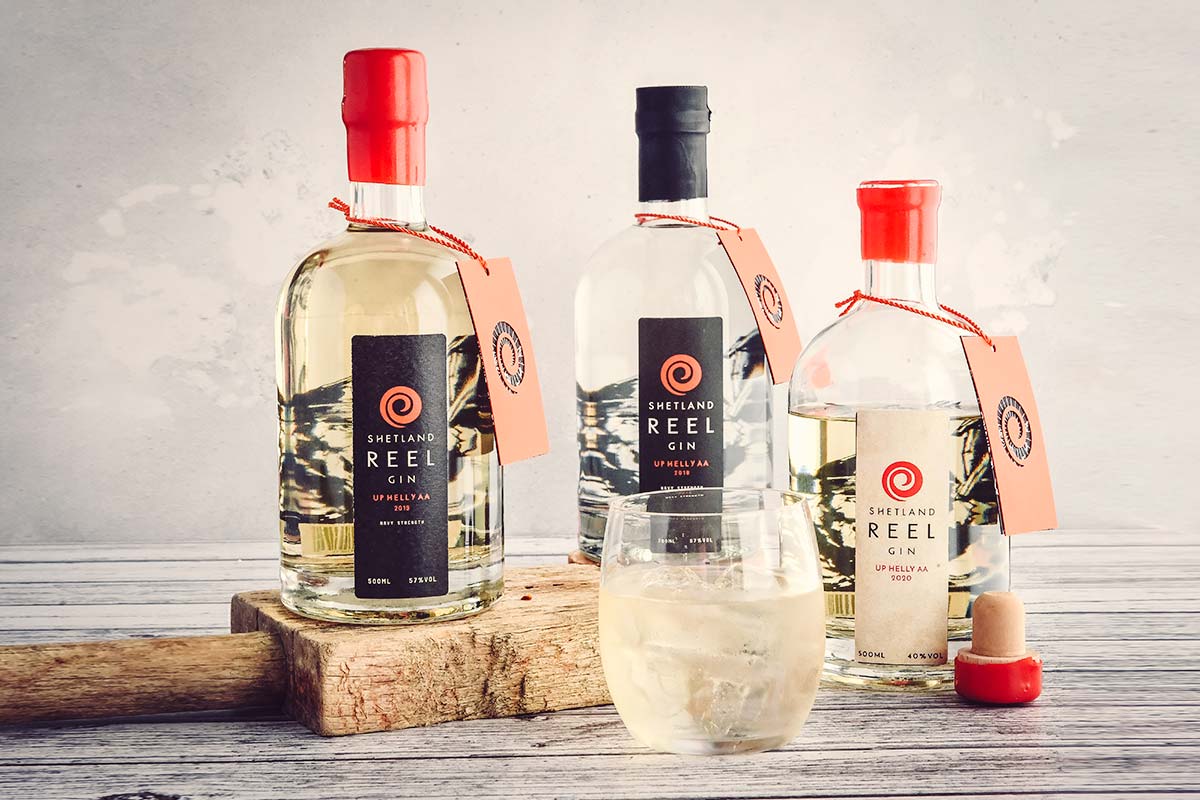
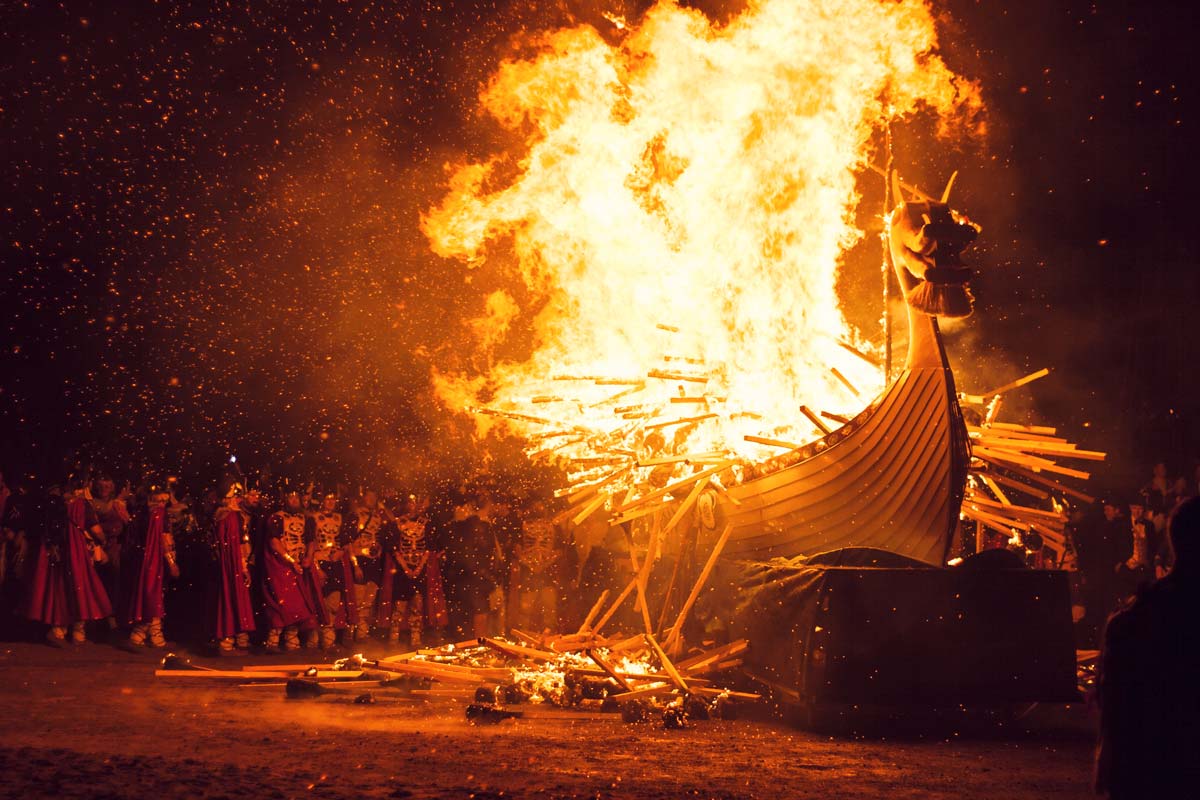
“Each year, we release a new Up Helly Aa Scottish Gin expression as a celebration of the Up Helly Aa festival. Our 2019 edition used a blend of 4 different casks that have all previously contained whiskies from some of the most prestigious distilleries in Scotland (Aberlour, Glenlivet, Glen Garioch). Ocean Sent gin was filled into the casks at 60% and was aged for up to three months before being bottled. This was the first release that was matured across multiple casks, each carefully selected by master distiller Stuart Nickerson. The cask ageing process helps to reduce the kick sometimes associated with navy strength gins. Using our award-winning Ocean Scent as the base of our 2019 edition, it has given this expression a huge depth of flavour thanks to its unique botanical – bladderwrack seaweed.
“Our 2020 edition followed the same production format with our Shetland Reel Ocean Scent aged in a Oloroso Sherry Cask providing rich and deep flavours although we went with the lower ABV of 40% for this batch. We had a 2021 bottle ready to go in the hope the festival would be open to the public again, but lockdown meant we launched the Not Up Helly Aa 2021 edition – sold out within a day. We respect and admire Shetland’s ties to the seas and very much look forward to the day we can launch our Up Helly Aa 2022 edition, which we hope will find Shetland and the world in a better place.”
Debbie Strang, Co-Founder, Shetland Reel
Learn more about Shetland Reel here.
Inspirited Spiced Navy Strength Gin (57.1% ABV), Inspirited Distillery
The Inspirited Distillery officially launched in 2019 with a unique and original distillery service that allows customers to create a bespoke gin online through the Inspirited website. With a selection of botanicals available, customers can choose up to 12 botanicals from a variety of 35 that the distillery would then use to distil and create a one-off gin.
Thanks to the distillery’s bespoke and custom-engineered still that was manufactured in Chicago with the input of founder and distiller Lawrence Nicholson and his dad, both from engineering backgrounds, the still was designed to simplify the distillation process for complex recipes. The distillery also launched their Inspirited Original Gin in late 2019 along with their Summer Berries and Hibiscus Gin in early 2020.
One of Scotland’s newer Navy Strength Gins and released in late 2020, Inspirited Spiced Navy uses an original recipe rather than using the Inspirited Original Gin recipe cut at the higher ABV of 57.1% ABV. The gin combines some of the more familiar and classical gin botanicals like juniper, coriander seed, grains of paradise, along with some less well known botanicals including Kentish cobnuts and galangal root.
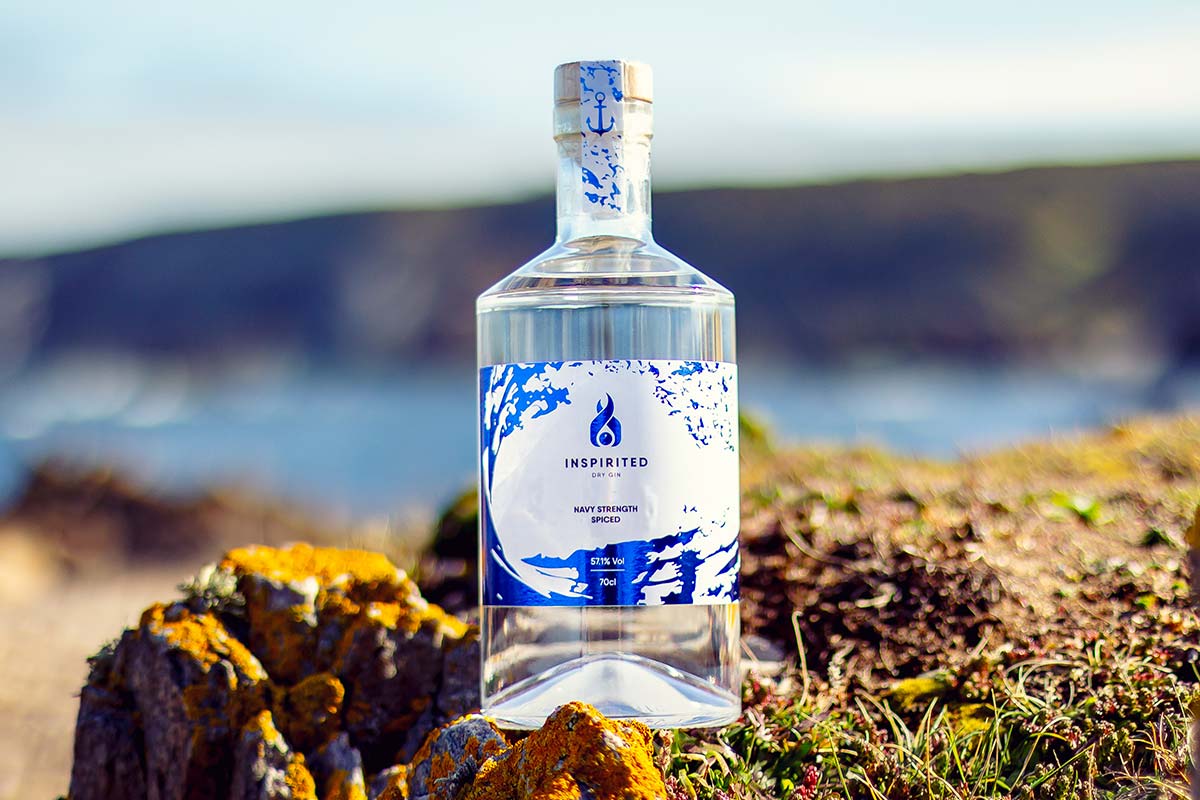
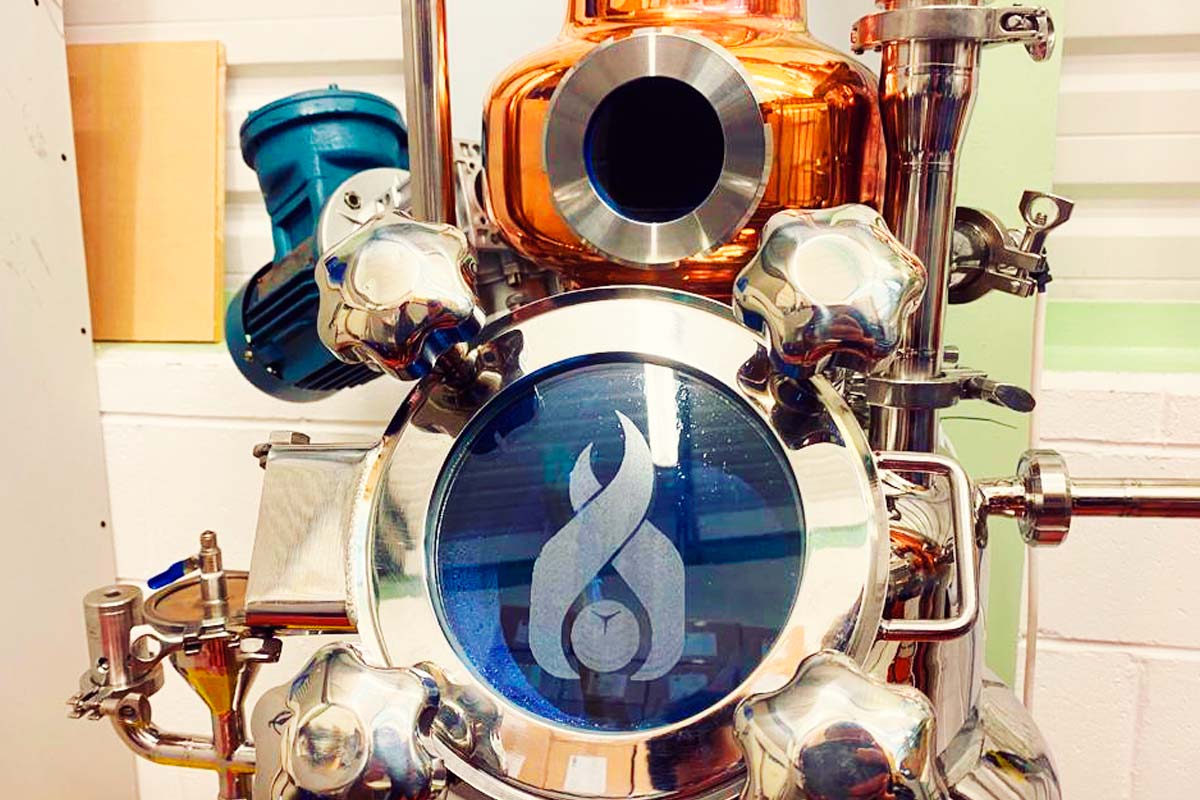
“We designed our Navy Strength gin from scratch to be complemented by a higher ABV. Simply increasing the ABV of our Original would have been the easy route, but the citrus-forward and subtle flavours of our Original would be all but lost. We have had great success with rich, flavourful spices in higher ABV drinks, which steered us towards ingredients such as Galangal, Pink Peppercorns and Cassia Bark. We did, however, want to add balance, a slight sweetness to take the edge off. This leads to the introduction of both our perennial favourite, Kaffir Lime Leaves and the new kid on the block for us, Kentish Cobnuts.
“We are continually trying new ingredients and flavours, but when we tried this sweet, admittedly odd-looking, nut which has the texture of coconut flesh but the flavour of a hazelnut, we knew it had a place in this gin. Our Navy Strength gin is packed with a slew of other botanicals, 12 in total, all of which we believe play a key role in maintaining a quality and complex flavour whilst ensuring a remarkable smoothness.”
Lawrence Nicholson, Founder and Distiller, Inspirited Distillery
Learn more about Inspirited here.
Pickering’s Navy Strength Gin (57.1% ABV), Summerhall Distillery
Located on-site at the Summerhall arts venue in Edinburgh, Summerhall Distillery is home to the Pickering’s Gin expressions and evolved from derelict dogs kennels as part of the old Royal (Dick) Veterinary School. Established by friends Marcus Pickering and Matt Gammel, Summerhall Distillery was the first exclusive gin distillery to be established in Edinburgh for over 150 years.
Since opening its doors in 2013 and releasing a number of Scottish Gin expressions, including a series of cask-aged gins and seasonal gins for Christmas, Pickering’s Gin has focused on flavour and fun. Their Christmas baubles for 2020 featured Christmas Clementine, Festive Cranberry, Spiced Pear & Cinnamon, Figgy Pudding, Plum & Ginger and Brussels Sprout Gin after all! And although the popularity of flavoured gin has continued to grow as consumers seek new taste experiences, Pickering’s have continued to inject their distillation expertise and personality into each of their gins creating something special with each Scottish Gin expression.
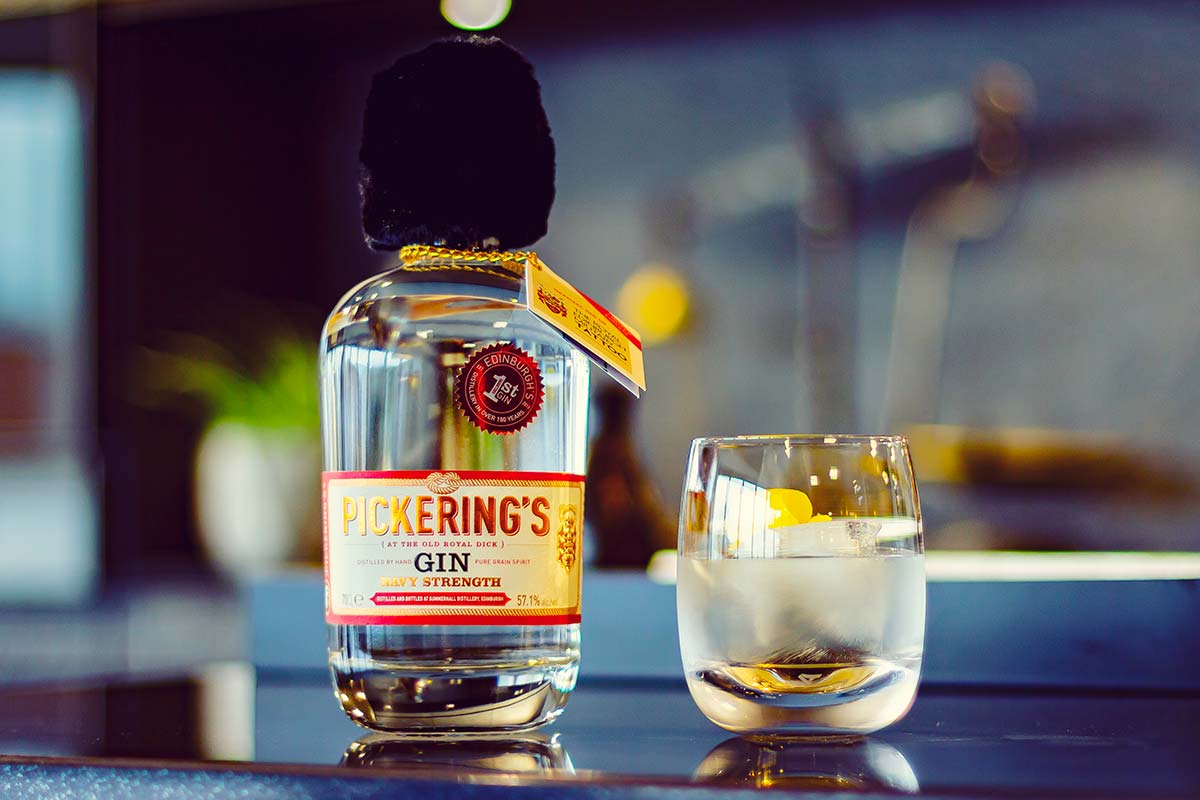
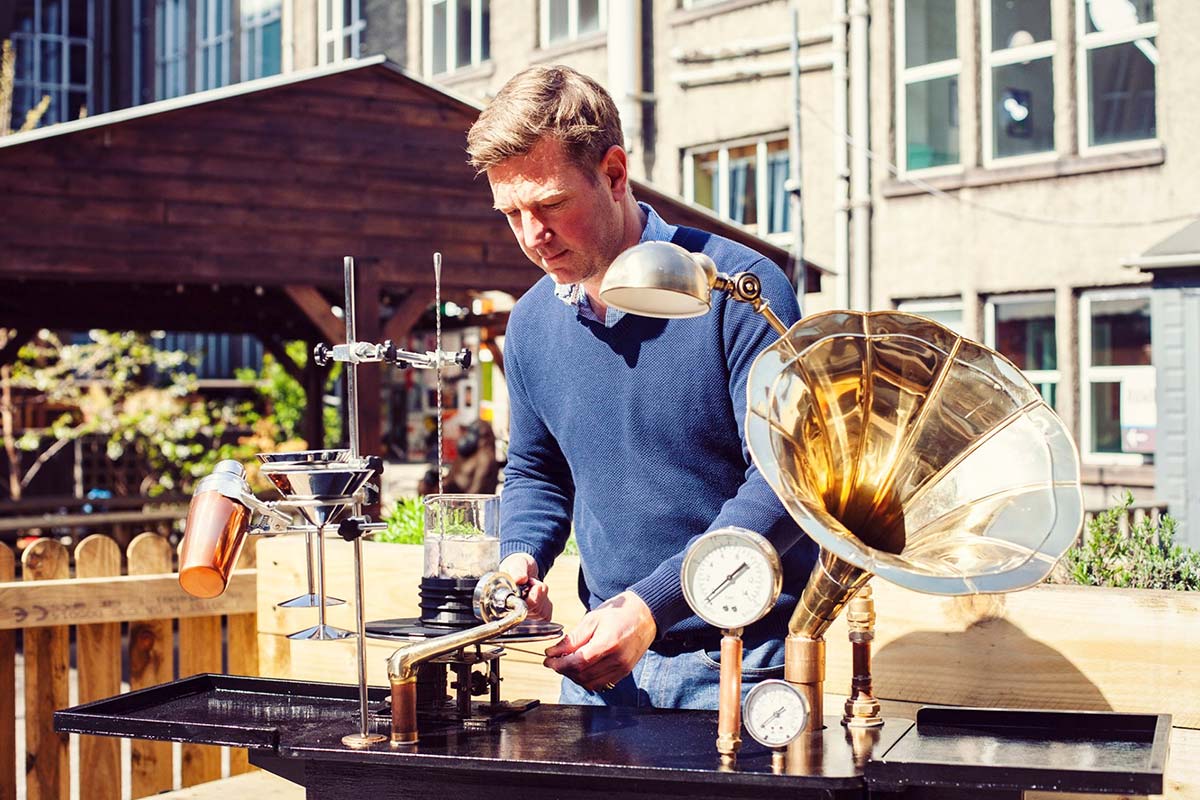
“In 2014, the Royal Edinburgh Military Tattoo spotted our little distillery and requested we distil them a special edition gin. So adored for its fuzzy little bearskin hat as much as its rich flavour, we decided to keep the ‘Bearskin Gin’ as part of the Pickering’s core range.
“Distilled to the same recipe as Pickering’s Gin but with a higher alcohol content; at 57.1%, more concentrated botanical oils are carried. So, as would be expected, this is a big, punchy juniper-forward gin. Exceptionally smooth and beautifully balanced, our Navy Strength is a more vivid expression of our modern take on the Pickering’s Bombay gin recipe. Hearty spice takes the supporting role, and it isn’t until this gin is diluted with tonic, or in a cocktail, that zingy citrus notes reappear – an interesting consequence of the higher ABV.”
Marcus Pickering, Co-Founder, Summerhall Distillery
Learn more about Pickering’s Gin here.
Kirkjuvagr Arkh-Angell Storm Strength Orkney Gin (57% ABV), The Orkney Distillery
Work on the The Orkney Distillery, home to the Kirkjuvagr Orkney Gin range of Scottish Gin expressions began in February 2017 before the distillery doors officially opened in July 2018. Having originally worked with the distillation team at Strathearn, Stephen and Aly Kemp had always hoped that one day they could bring their distillation back to Kirkwall, the capital of Orkney.
With its Nordic links and ties to Vikings and the oceans, Orkney has a rich and proud seafaring heritage. It’s little wonder that Stephen and Aly have incorporated the island’s history along with their own family ties to the islands. It’s also a big responsibility for any gin maker or gin brand to closely tie their products and business to an area’s history and culture. People can be fiercely proud of their culture, their history and the place they call home, so it’s most definitely something you’d better do it right and do it well.
From the offset, Stephen and Aly knew the importance of building a brand that they felt balanced the modern Orkney with a foot in the past and a foot in the future. With their products, distillery and brand, Stephen and Aly have struck the right balance of storytelling, weaving their own personal experiences of Orkney, its history and folklore into everything they do.
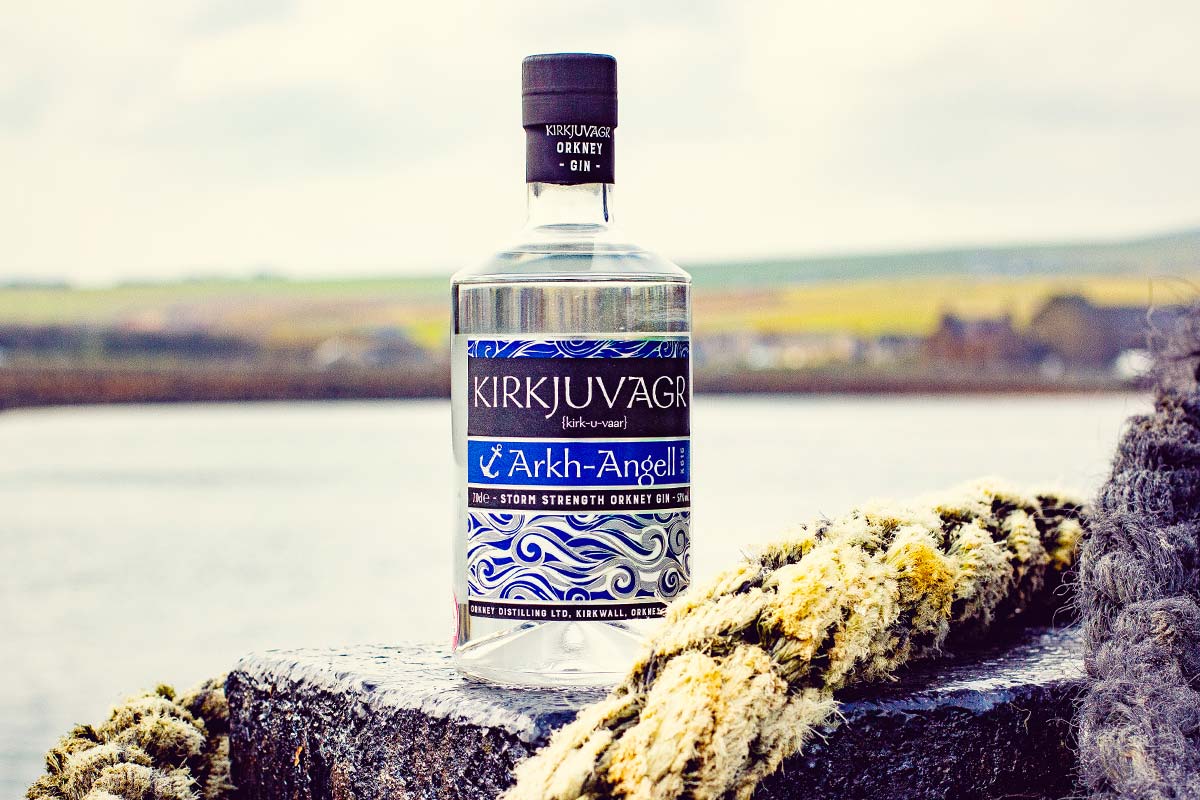
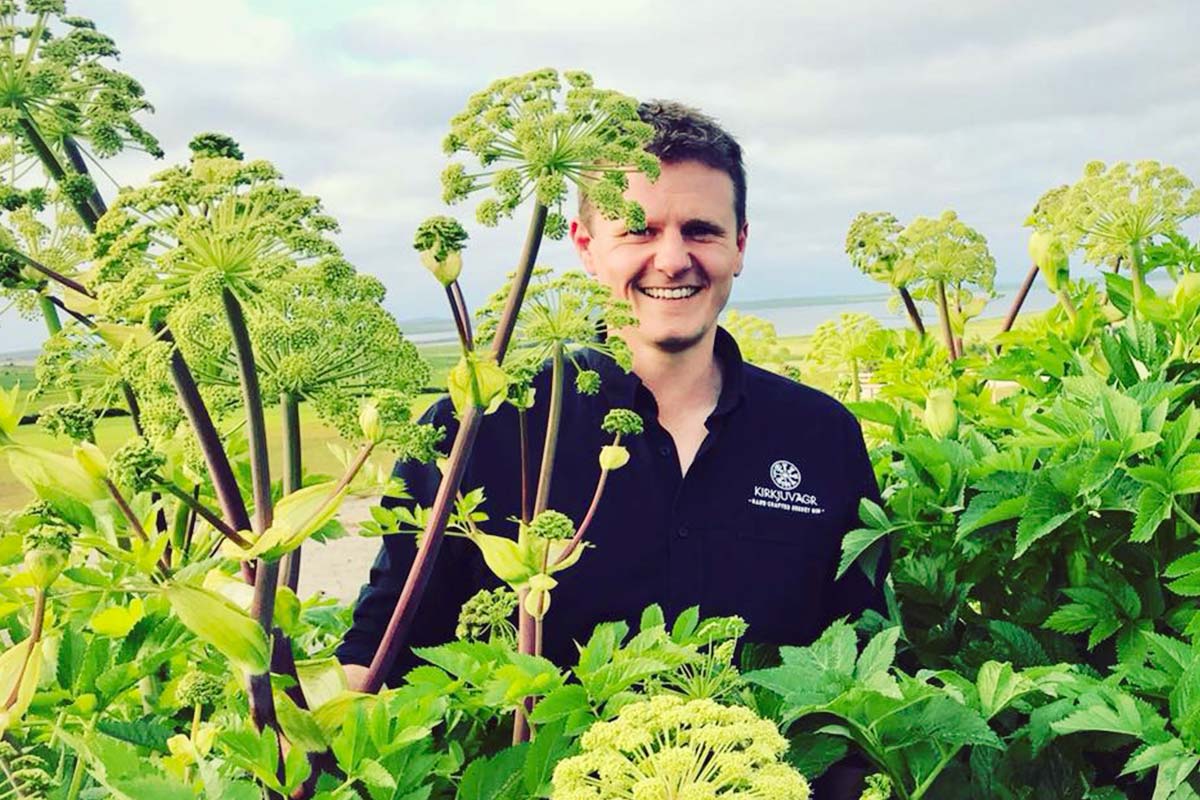
“We had always hoped, based on the success of our signature Kirkjuvagr Orkney Gin, that we could create a Navy Strength version. As part of the process of trying to incorporate some local botanicals in our gins, we sought the input and expertise of Dr Peter Martin from the Agronomy Institute, the research centre within the University of the Highlands and Islands that specialises in plant research and plant-based projects including food and drink.
“By chance, the Agronomy Institute at The Orkney College were carrying out a study of local botanicals that uncovered a unique species of Angelica – Angelica archangelica, that was only found in Iceland, Northern parts of Norway, the Faeroe Islands, Greenland, Northern Russia and Orkney. After investigation and research, it was discovered that the Vikings had brought the species of Angelica with them, and that explained why it was only found in some of the northern regions and not others. It had been brought here and slowly cultivated over centuries before it spread and started to grow wild. It was amazing to have this direct link to our Viking ancestors and have a completely unique botanical that we could harvest locally and use in our gin. And thanks to being able to use the seeds from the harvested Angelica archangelica, we were able to plant and cultivate our own crops for use in our Kirkjuvagr Arkh-Angell Storm Strength Orkney Gin. The Nordic Studies report also mentioned that our special strain of Angelica appeared to originate in Orkney on the isle of Westray.
“By sheer coincidence, my wife Aly’s late father was born and raised on Westray, and it was here he learnt his trade as a fisherman and skipper. He’d fished in all manner of seas – rough, smooth and as you can imagine some very dangerous storms, at the helm of his boat the “Arkh-Angell”, which was a well known boat in the Orkney fishing community. When we tied it all together with the archangelic botanical connection and Aly’s links to Westray and Orkney, we named our Navy Strength gin Arkh-Angell Storm Strength Orkney Gin, a fitting tribute to Aly’s dad and our proud Orcadian heritage.”
Stephen Kemp, Co-Founder, The Orkney Distillery
Learn more about Orkney Distilling here.
Inshriach 57% Navy Strength Speyside Dry Gin (57% ABV), Inshriach Distillery
It could safely be described as one of Scotland’s most unusual gin distilleries, featuring not only a distillery but a saloon, a yurt, a log cabin, a country house, along with some friendly local chickens. Based on the Inshriach estate on the outskirts of the highland town of Aviemore, the Inshriach estate and distillery, home to Inshriach Gin, is anything but dull. Winner of Channel 4’s Shed of The Year 2015, the Inshriach Distillery has been a site of gin production for over 8 years.
Established by owner and distiller Walter Micklethwait, the distillery currently produces a number of Scottish Gins, including the two core Inshriach Gin expressions, as well as supporting a number of other gin makers and brands with their gin production. Using responsibly foraged botanicals, including Scottish juniper, and a traditional handmade Portuguese copper alembic still, Inshriach Navy strength follows the same botanical make-up as the signature gin, but the botanicals in the Navy are amplified. The gin is proud in its simplicity but revels in showcasing its botanicals with every sip.
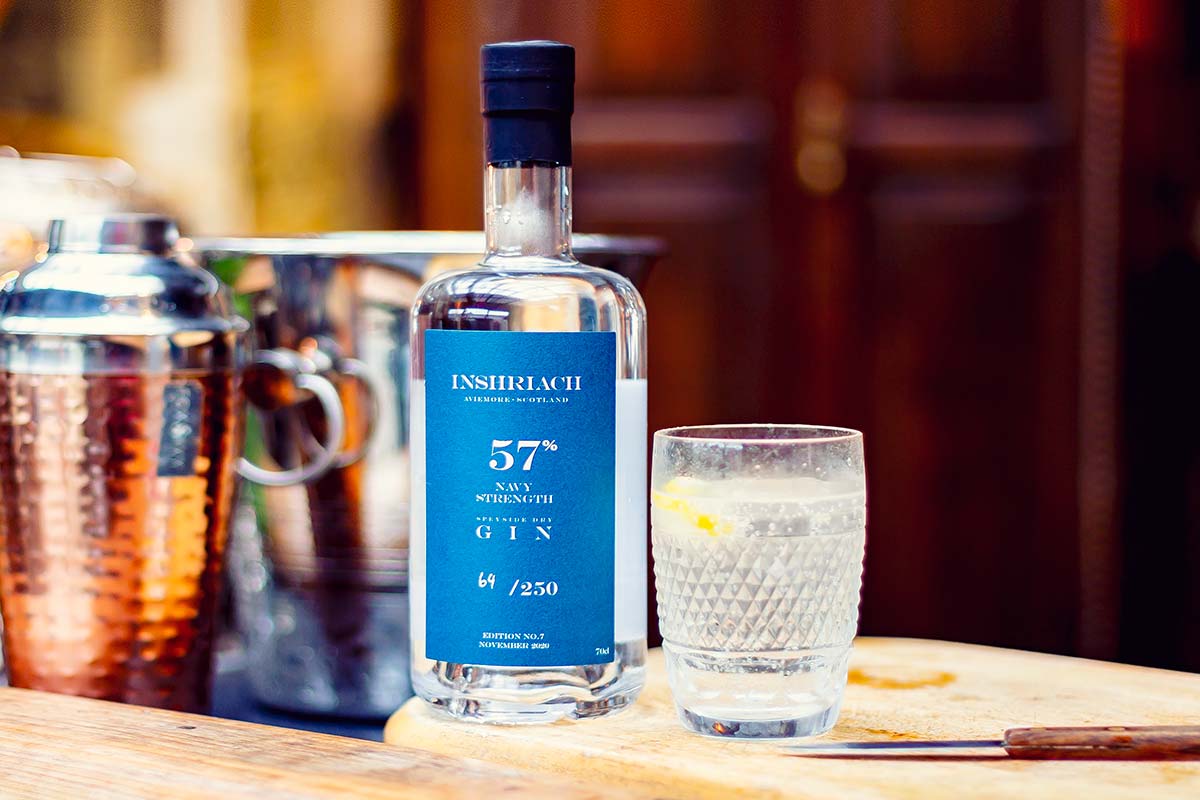
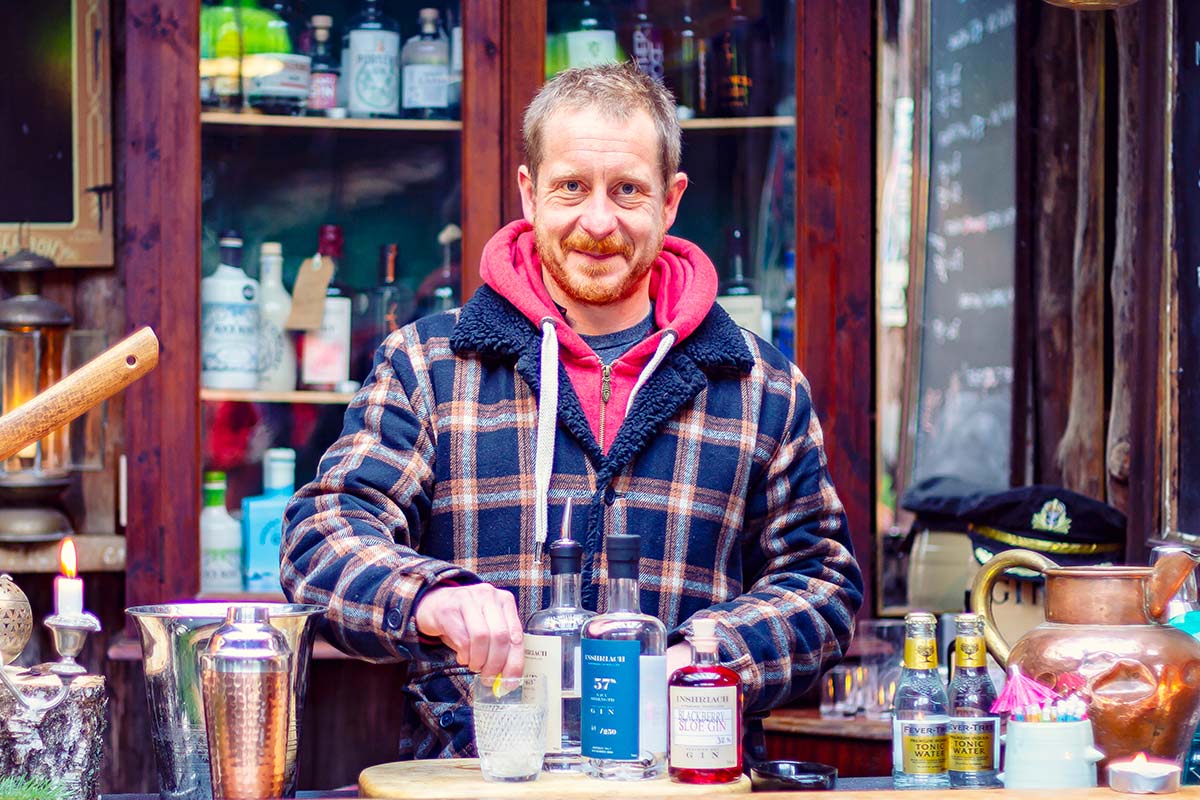
“Inshriach Navy Strength Gin uses the same botanicals as our Inshriach signature gin except we change the ratios of each botanical, especially the Douglas fir needles, which can dominate the flavour at the higher ABV. The Inshriach Navy Strength Gin is most definitely a more mischievous big sibling to our signature gin. Bolder botanicals, more punch at the higher ABV and a navy strength that can be enjoyed neat over ice, in a classic G&T or has enough juniper backbone and botanical strength to hold up in a number of gin-based cocktails.”
Walter Micklethwait, Founder and Distiller, Inshriach Distillery
Learn more about Inshriach here.
LoneWolf Gun Powder Gin (57%ABV), BrewDog Distillery
One of the few brands that dragged the craft of brewing kicking and screaming into the 21st century, BrewDog has grown from two mates brewing beers in their garage in the North East of Scotland to a global giant with bars and beer hotels around the world. Opinionated. Bold. And sometimes throwing common sense out the window, BrewDog have continued to do things their way, for right or wrong.
With the Brewdog Distillery opening its doors in 2016, the distillery launched its signature LoneWolf Gin in April 2017 along with a range of tonics. The focus of the distillery with its nine-meter tall, 60-plate rectification column was to create spirits that use the in-house base spirit underlined with the Brewdog spirit of experimentation, creativity, adventure, story and flavour.
With a variety of stills, including the world’s only triple copper bubble still, the distillation team led by head distiller Steven Kersley, have continued to create a range of Scottish Gins and spirits including their Zealots Heart Gin, Five Hundred Cuts Botanical Rum, Rogue Wave Vodka and a number of LoneWolf Gin expressions.
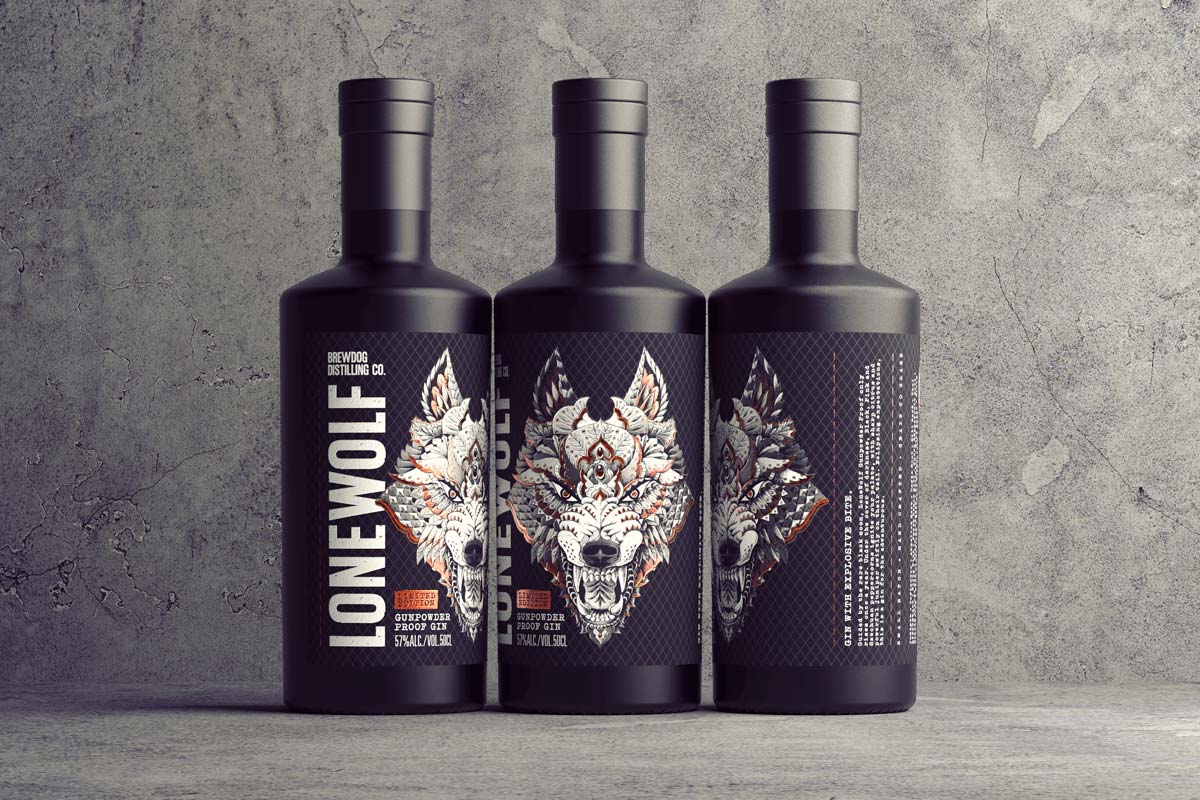

“We created LoneWolf Gunpowder Gin in time for Bonfire night 2019. The inspiration for this gin was to test just how far we could amplify the classic flavours in our classic London Dry LoneWolf Gin. Upping the ABV intensifies the flavour, the juniper is super pronounced, the bitter orange, star anise, Szechuan, pink and black peppercorns all come through, with an underlying layer of bright citrus. It’s great in a classic Martini but my favourite is in a Martinez with sweet vermouth and orange Curaçao as it’s one hell of a smoked orange hit!”
Steven Kersley, Head Distiller, Brewdog Distilling Co.
Learn more about BrewDog Distilling Co. here.
Johannistag Navy Strength Old Tom (57% ABV), Orkney Gin Company Distillery
Johannistag was a first for Scottish Gin – both a Navy Strength and an Old Tom style gin and released to mark the scuttling of the German fleet at Scapa Flow on the 21st of June 1919 near the end of WW1. Johannistag uses Orcadian honey sourced in nearby Shapinsay to create the slightly sweeter taste. The botanicals reflect Orkney’s summer months, including juniper, honey, rose and heather. Johannistag is also German for Mid Summers Day or St John’s Day. A percentage of the profits raised from the sale of Johannistag were donated to Orkney’s RNLI, a vital service that was officially established in 1972. The crews have been awarded three medals for gallantry during their lifesaving history.
Produced at the Orkney Gin Company in the small village of Burray and just a stone’s throw from Scapa Flow, Gary and Andrea Watt were the first gin producers on the island. Taking their influences from the local area, the small family business have nurtured their range of Scottish Gin expressions to capture the seasons. With Gary’s own ties to the seas having been around the fishing industry most of his life and when not in the distillery working as the captain on one of the ferry services, Gary and his family have a long-held respect for the power of the seas and their influences over the way of life in Orkney.
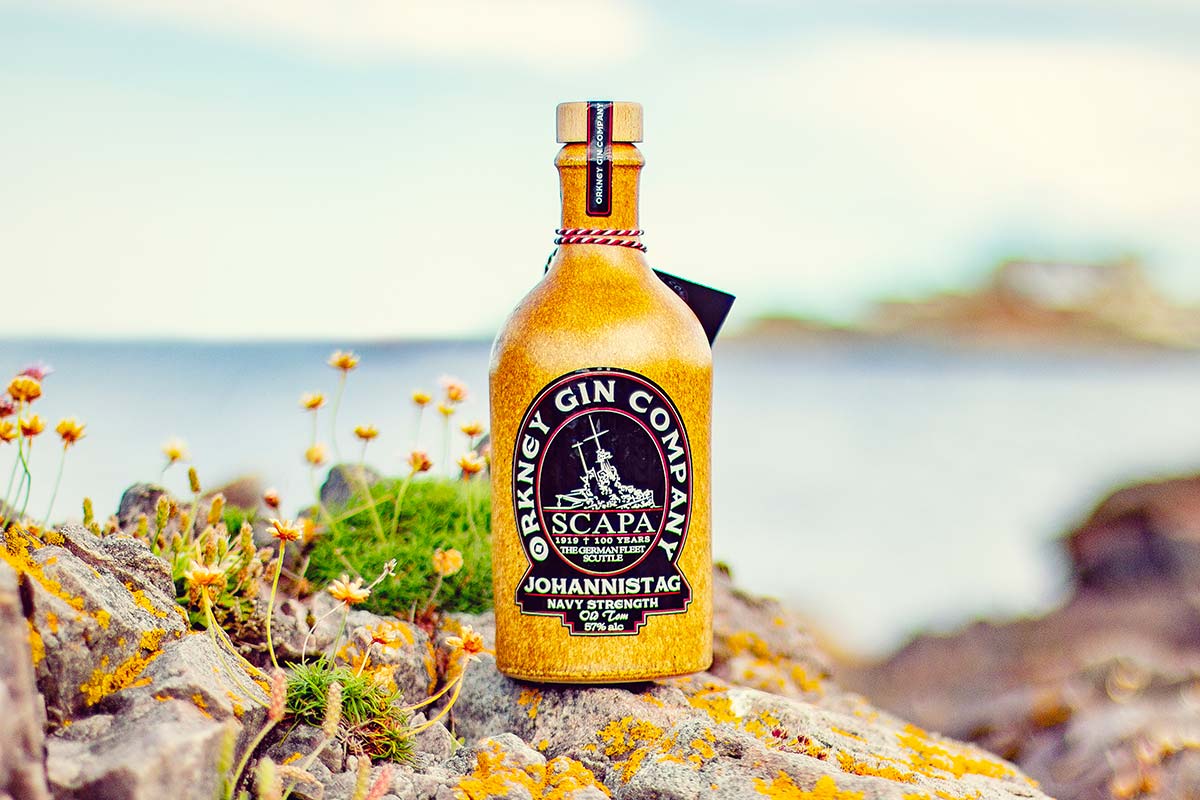
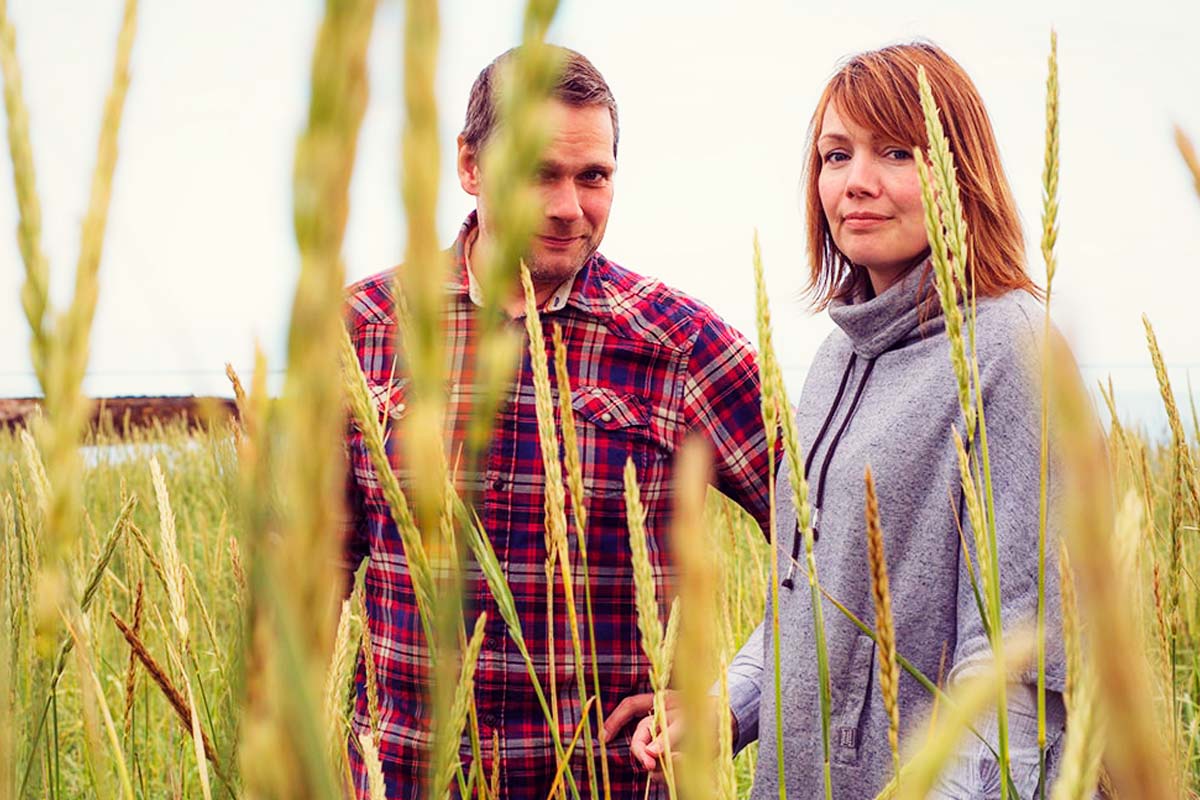
“To mark and pay tribute to an event that shaped WW1 and the Orkney Islands forever, we were commissioned by a descendant of Admiral of the Fleet John Rushworth Jellicoe to create a very special commemorative Scottish Gin. Cold compounded and bottled at 57%, our new Johannistag Navy Strength Old Tom was released as a batch of 500 at the end of November 2018, to coincide with the date the German Imperial Navy entered Orkney’s Scapa Flow. The second, and final 500 bottles were released in June 2019 to commemorate the last event that would forever place Scapa Flow in the history books for its importance in WW1.
“After the Armistice was announced, it was decided that the German Imperial Navy should be taken off the high seas, and it was agreed the fleet would be harboured at the Royal Navy’s base at Scapa Flow in Orkney. This was agreed as part of the Armistice that brought an end to WW1.
“Whilst negotiations took place over the fate of the ships, which were still crewed by German sailors, under the command of Admiral Ludwig von Reuter. It had been rumoured the fleet would be divided amongst the allied powers, and out of fear of this possibility, the Admiral gave the order to scuttle the fleet.
“The name ‘Johannistag’ is German, and translates to Mid Summers Day, or St John’s Day. The botanicals in Johannistag reflect Orkney’s summer climate, with bright refreshing floral notes and a smooth Old Tom style finish, lightly sweetened using Orcadian honey sourced in Shapinsay, one of Orkney’s North Isles.”
Gary Watt, Co-Founder and Distiller, Orkney Gin Company
Learn more about Orkney Gin Company here.
Crossbill 200 Single Specimen Dry Gin 2020 (59.8% ABV), Crossbill Distillery
Established in 2013, Crossbill Distillery put the focus on using a select number of Scottish only botanicals in their gin. Originally based in the heart of the Cairngorms before relocating to the famous Barras in Glasgow, the team at Crossbill still visit the Cairngorms where they sensibly forage for the botanicals that are used in their gin distillations. It was during one of these foraging trips they discovered, amongst the crop of wild Scottish juniper, a juniper tree that appeared to be significantly more mature than many of the surrounding trees.
With a little research, the age of the juniper tree was put at over 200 years old. Along with the rose hips from the surrounding land, the juniper from this tree makes up the two key botanicals that go into making Crossbill 200 Single Specimen Dry Gin. And because the weather and climate have an influence over the plant’s growth and juniper production, every year’s edition of the Crossbill 200 Single Specimen Dry Gin offers subtle variations making each edition unique.
With their distillery and gin school in urban Glasgow, all gin distillation takes place there using a 150 litre Bain Marie fired copper pot still. And although the distillery and business is based in Glasgow, the inspiration and heart of Crossbill remains truly in the Highlands.
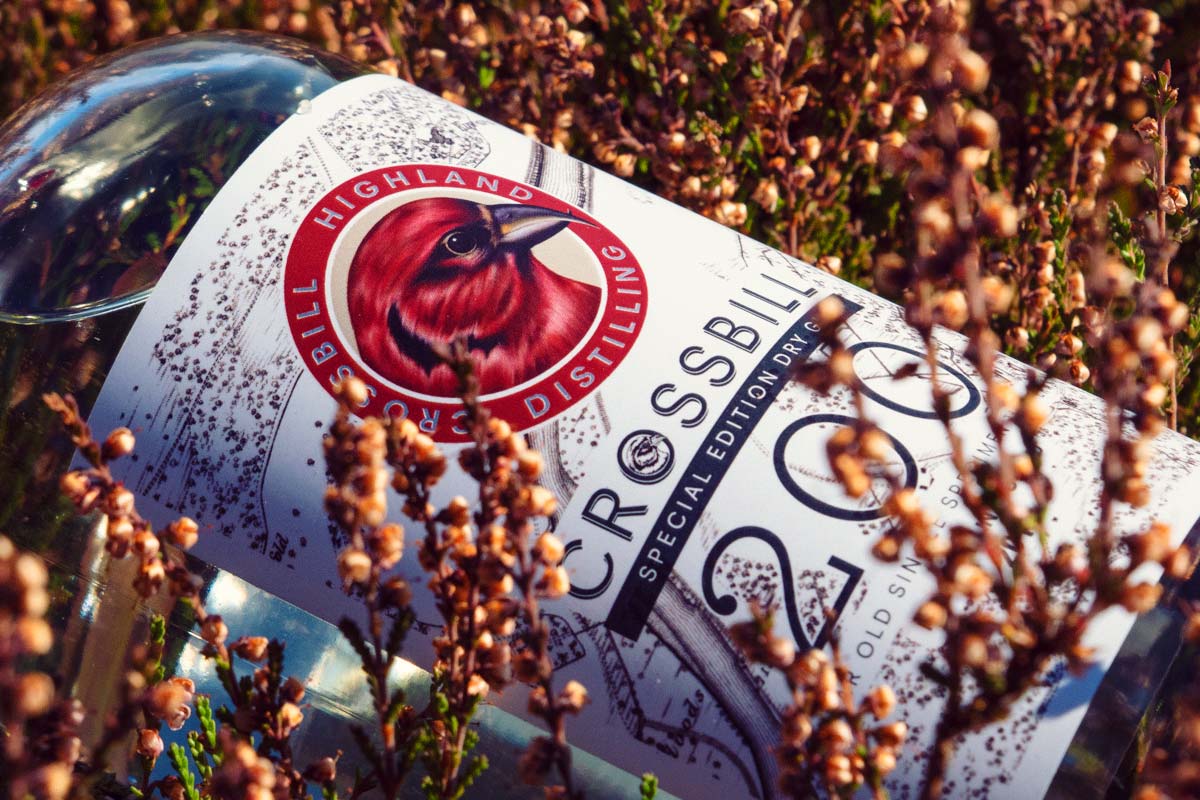
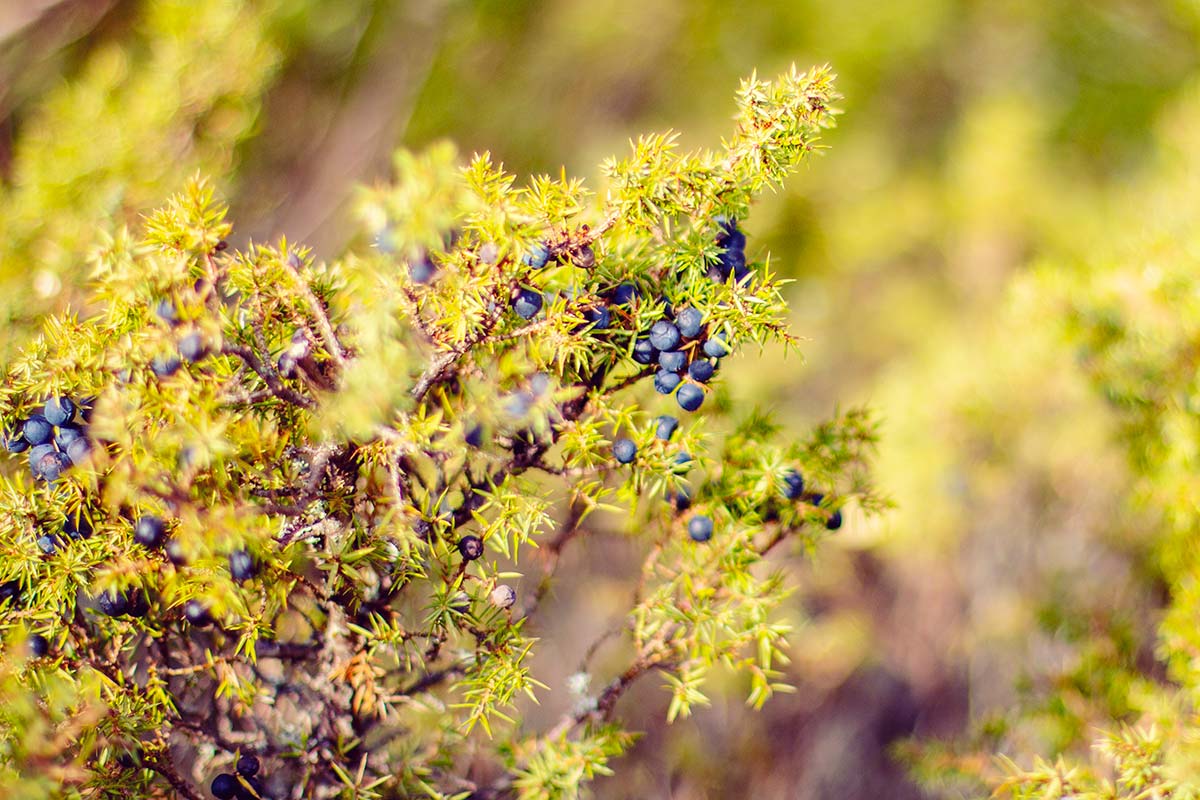
“Crossbill 200 Single Specimen Dry Gin 2020 is macerated with fresh rosehips and juniper from our very special juniper tree in the Cairngorms. Because native juniper is at risk, we are very selective, careful and considered when we forage for our botanicals. We have a duty of care to the local area so we only forage just enough to help with our gin production. We want to ensure our impact is kept to a minimum and that we leave enough plants so we can ensure not only a habitat for wildlife but that we help with the regeneration of the wild juniper.
“We only distil one batch of the Crossbill 200 Single Specimen Dry Gin in any year. And although we use the juniper from the same tree in each annual release, the climate and landscape in any given year can vary greatly. The result is there are subtle differences between each year’s edition. Distilled and bottled at 59.8% ABV, the higher ABV really helps extract all the flavours and oils from the botanicals. It means the gin has a rich viscosity, deeper, more complex and intense flavours and a creamier mouthfeel. And even at the higher ABV, it’s well balanced and can be enjoyed neat over ice as sipping gin.”
Stewart Caldow, Business Development, Crossbill Distillery
Learn more about Crossbill Distilling here.
Darnley’s Navy Spiced Gin (57.1% ABV), Darnley’s Gin Cottage Distillery
The inspiration for this gin was Sir Rosslyn Wemyss, a descendent of the Wemyss family who has ties to Scotland and spirits dating back over 180 years. Sir Rosslyn Wemyss had an illustrious career in Royal Navy between 1877-1919, eventually retiring as Admiral of the Fleet. With a rich family heritage to draw upon for inspiration and gin’s association with the Navy, adding a Navy Strength Gin to the range of gin expressions allowed Darnley’s to explore and develop a unique spiced flavour profile.
Launched in 2010 and originally produced outside of Scotland, distillation was brought back to Fife in Scotland when the new Kingsbarns Distillery and Darnley’s Gin Cottage Distillery opened their doors in 2017. Under the watchful eye and tastebuds of head gin distiller Scott Gowans, the already popular Darnley’s Navy Spiced Gin was tweaked slightly and built upon for distillation in the new copper pot still named “Dorothy”.
This award-winning gin uses the same spiced botanicals that feature in the Darnley’s Spiced Gin expression, but with an increased amount of juniper. Bottled at 57.1%, the result is a bold, juniper-led gin with waves of warming, rich scented spices and plenty of body and depth.
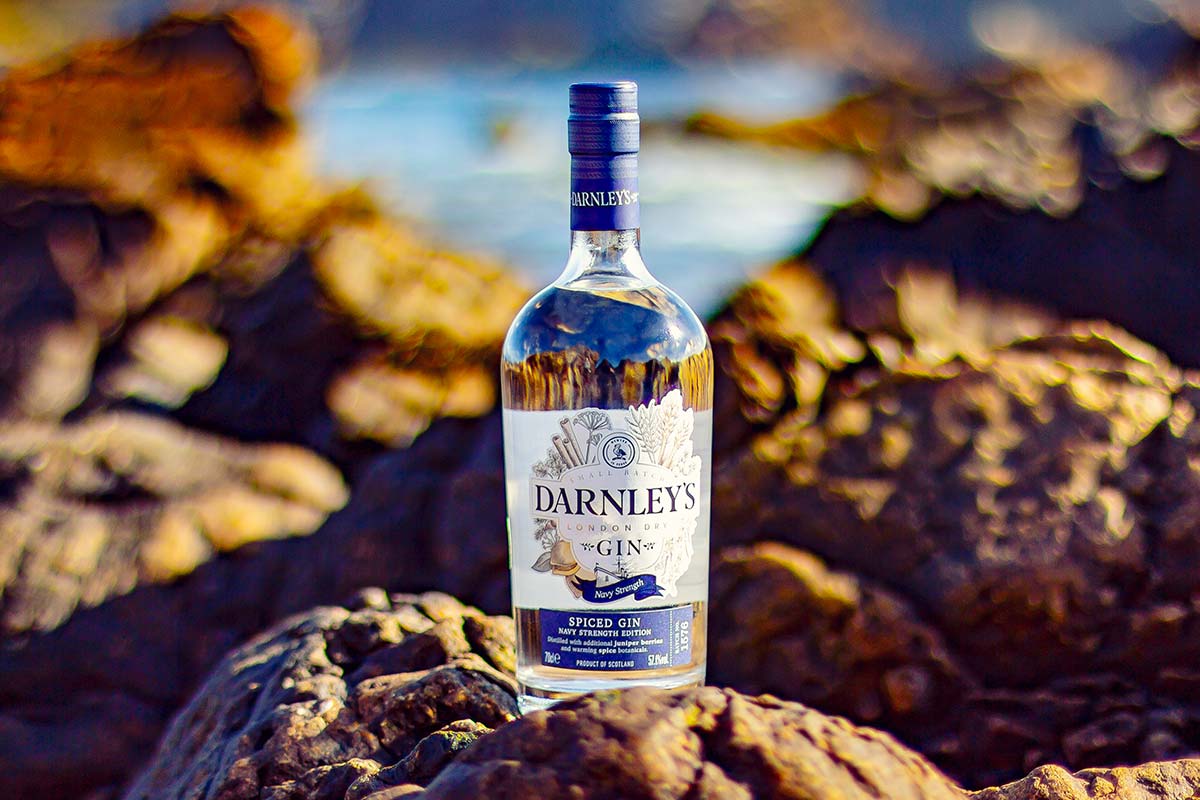
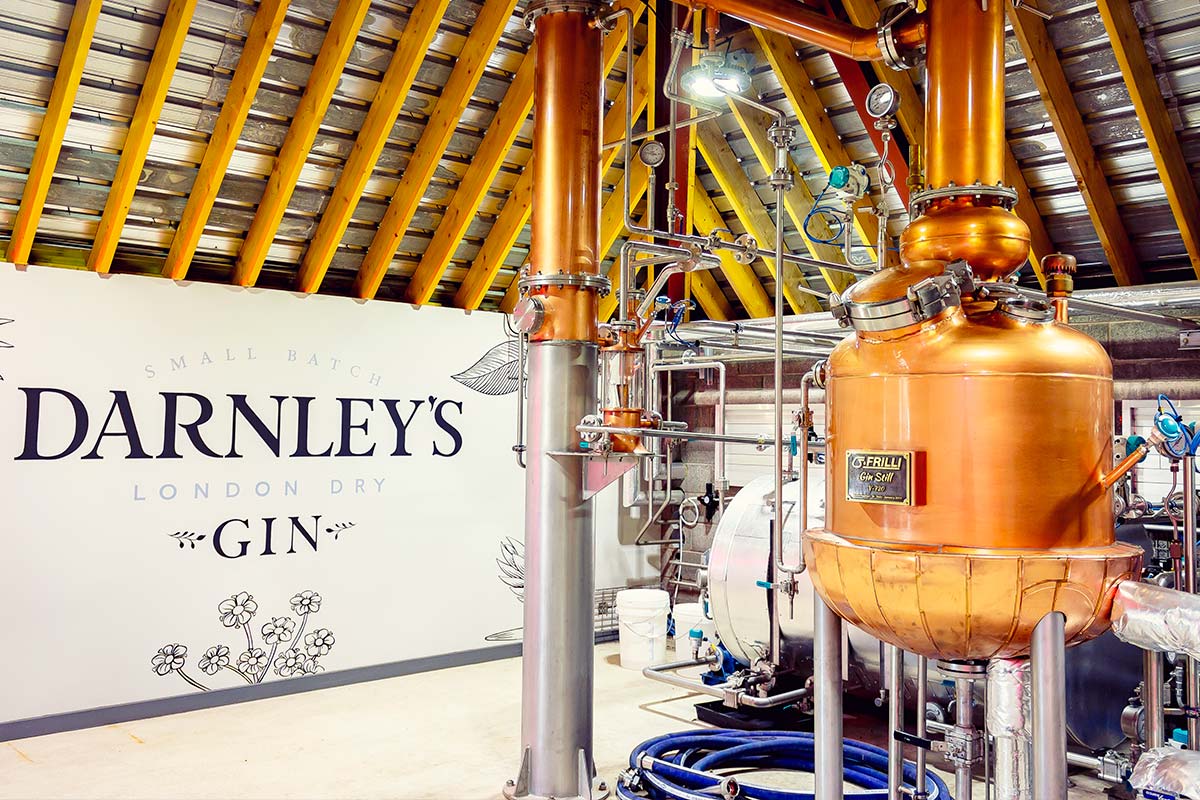
“At 57.1% ABV, the botanicals in our Navy Strength Gin really stand up to other flavours. Tonics or in cocktails, our Navy Strength really works well with mixers. But not only that, it can also be enjoyed neat over ice. This can raise a few eyebrows, especially with the higher ABV but we’ve managed to really balance the flavour profile of the spiced botanicals including cinnamon, nutmeg, clove and ginger along with the juniper and other classic gin botanicals to create a gin that I really enjoy neat or in a negroni.”
“It’s a big responsibility being in charge of the gin distillation at the distillery, especially as we distil every batch using taste and nose. It means there’s no computers to tell me when I need to cut the heads, hearts and tails from any of the distillations. Everything is done purely on taste and aroma. This process allows us to have total control over the final flavour of all our gins, and although we’ve got each recipe for all our three core Scottish gins down to what I would call ‘a fine art’, we’re continually keeping a watchful eye and nose on each batch to ensure it meets our customers expectations. When our Darnley’s Navy Spiced Gin picked up double gold at the International Spirits Competition in 2020, we were delighted that all our hard work here at the distillery in Fife had been recognised in what is a really tough and well respected spirits competition.”
Scott Gowans, Head Gin Distiller, Darnley’s Gin Cottage Distillery
Learn more about Darnley’s Gin here.
As the number of Scottish Navy Strength Gins continues to grow and distillers and brands look at new ways of exploring the 57% and above ABV mark, it’s a style of gin that excites the imagination and most definitely provides a platform for showcasing just how diverse gin can be. A classic but bold G&T. A full bodied and punchy Negroni cocktail or an elegant martini. Simply drank neat over ice. There’s simply nowhere to hide when it comes to Navy Strengths. We’ve come to know and love the stories and spirits above that make up the Scottish Navy Strength Gin category and this list is a great place to start for anyone wishing to start or continue their journey into the category.
To learn more about the great Scottish Navy Strength Gins above and others, you can visit our comprehensive A-Z of Scottish Gin here, sort by Gin Style and scroll to Navy Strength.

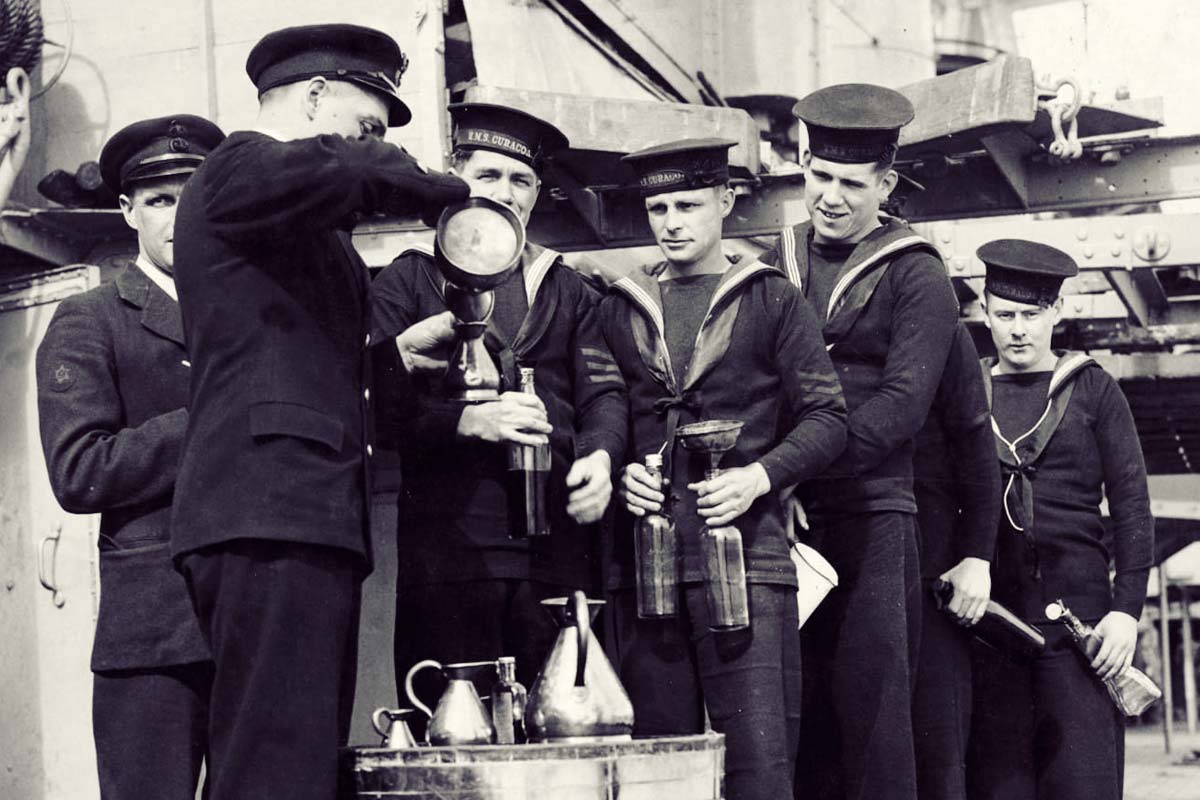
You can learn more about the many great Scottish Gins by visiting the links below.